Paper Menu >>
Journal Menu >>
 Vol.2, No.12, 1349-1365 (2010) Health doi:10.4236/health.2010.212201 Copyright © 2010 SciRes. Openly accessible at http://www.scirp.org/journal/HEALTH/ Emotional categorization: individual emotional differences and laterality effects in healthy and persons with multiple sclerosis Farzaneh Pahlavan1*, Tudd Lubart2, Michelle Montreuil3, Stephen Jacob2, Anne-Yves Jacquet2, Christelle Lemoine2, Hélène Petropoulou3, Franck Zenasni2 1Laboratoire de Psychologie Sociale, Université Paris Descartes, Boulogne, France; *Corresponding Author: farzaneh.pahlavan@parisdescartes.fr; 2Laboratoire de Psychologie et Neurosciences Cognitives – CNRS, Université Paris Descartes, Boulogne, France; 3Equipe de Recherche en Psychologie Clinique, Université Paris 8 Saint-Denis, Paris, France. Received 1 October 2010; revised 20 October 2010; accepted 25 October 2010 ABSTRACT A study examining affective information processing in persons with Multiple Sclerosis and healthy adults was carried out. It was hy- pothesized that individual characteristics could modulate participants’ emotional categorization and reaction times for categorization decisions. For example, individuals w ith negative valenced emotional profile (e.g. anxious) should choose negative emotional alternatives faster and more frequently. Participants consisted of two differ- ent populations: 80 right-handed healthy French-speakers, and 40 right-handed French- speakers with multiple sclerosis. The results showed a positive correlation between high- level of negative emotional sensibility and emo- tional categorization (decision and decision speed) for affective information presented on the right-side of the screen. For all participants there were more fre quent emo tional choices a nd faster decis ions for left-side prese nted em ot io na l alternatives. It seems individuals’ emotional dif- ferences in general and in MS populations mo- dulate hemispheric asymmetry of processing emotional judgments. Keywords: Emotion; Categorization; Hemisphe ric Asymmetry; Individual Emotional Differences; Multiple Sclerosis 1. EMOTIONAL CATEGORIZATION: INDIVIDUAL DIFFERENCES AND LATERALITY EFFECTS There are numerous ways in which emotions and af- fective processes shape and organize cognitiv e activities. Some studies demonstrated creative, explorative beha- vior under positive mood and careful, error-avoidance behavior for negative mood (e.g. [1-5]; see also [6]). It has been also reported that emotional states can enhance high-level cognitive control [7], focus attentional re- sources, influencing encoding and organization of new information [8], and facilitating access to information previously acquired [9,10]. The influence of mental re- presentation of affective reactions on the accessibility of concept and knowledge has been also suggested [11,6]. Individual differences seem also be related to emo- tional reactivity and processing information, specifically emotional-relevant information (e.g. [12-14]). Our know- ledge of the ways in which individual differences and personality traits are associated with different affective and cognitive processes has grown considerably in re- cent years (e.g. [12-14] see also [6]). For example, it has been shown that typical happy people perceive, categor- ize, and retrieve pleasant information more readily, more easily than typical unhappy people, and may even in- terpret ambiguous stimuli more favorably [15,16]. In the same manner, an anxiety-related responses bias [17] and also an attention bias resulting in interpretation of am- biguous stimuli as threatening ones have been noticed in typical anxious individuals [18]. Therefore, researchers have proposed hypotheses about the affective- con- gruency [19] and trait-congruency [20]. Nevertheless, less work has been devoted to uncover- ing the basic factors of these influences, considering neuropsychological evidence in analyzing individual dif- ferences and affective-cognitive processes. In th e last few years, however, this situation has begun to change. Con- siderable evidence demonstrated that individual differ- ences, for example, in temperament are associated with 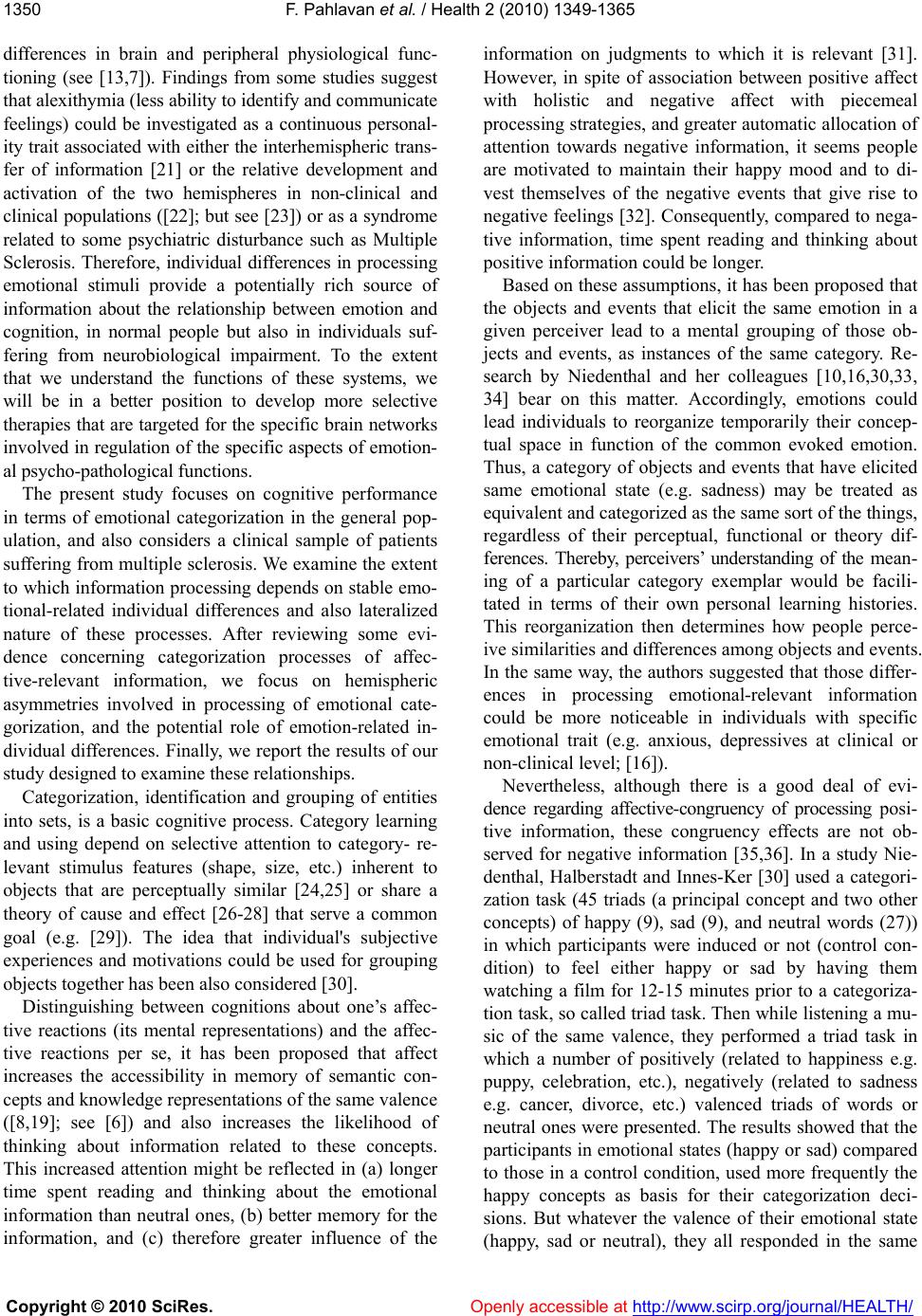 F. Pahlavan et al. / Health 2 (2010) 1349-1365 Copyright © 2010 SciRes. Openly accessible at http://www.scirp.org/journal/HEALTH/ 1350 differences in brain and peripheral physiological func- tioning (see [13,7]). Findings from some studies suggest that alexithymia (less ability to identify and communicate feelings) could be investigated as a continuous personal- ity trait associated with either the interhemispheric trans- fer of information [21] or the relative development and activation of the two hemispheres in non-clinical and clinical populations ([22]; but see [23]) or as a syndrome related to some psychiatric disturbance such as Multiple Sclerosis. Therefore, individual differences in processing emotional stimuli provide a potentially rich source of information about the relationship between emotion and cognition, in normal people but also in individuals suf- fering from neurobiological impairment. To the extent that we understand the functions of these systems, we will be in a better position to develop more selective therapies that are targeted for the specific brain networks involved in regulation of the specific aspects of emotion- al psycho-pathologi cal funct i ons. The present study focuses on cognitive performance in terms of emotional categorization in the general pop- ulation, and also considers a clinical sample of patients suffering from multiple sclerosis. We examine the extent to which information processing depends on stable emo- tional-related individual differences and also lateralized nature of these processes. After reviewing some evi- dence concerning categorization processes of affec- tive-relevant information, we focus on hemispheric asymmetries involved in processing of emotional cate- gorization, and the potential role of emotion-related in- dividual differences. Finally, we report the results of our study designed to examine these relatio nships. Categorization, identification and grouping of entities into sets, is a basic cognitive process. Category learning and using depend on selective attention to category- re- levant stimulus features (shape, size, etc.) inherent to objects that are perceptually similar [24,25] or share a theory of cause and effect [26-28] that serve a common goal (e.g. [29]). The idea that individual's subjective experiences and motivations could be used for grouping objects together has been also considered [30]. Distinguishing between cognitions about one’s affec- tive reactions (its mental representations) and the affec- tive reactions per se, it has been proposed that affect increases the accessibility in memory of semantic con- cepts and knowledge represen tatio n s of the same valence ([8,19]; see [6]) and also increases the likelihood of thinking about information related to these concepts. This increased attention might be reflected in (a) longer time spent reading and thinking about the emotional information than neutral ones, (b) better memory for the information, and (c) therefore greater influence of the information on judgments to which it is relevant [31]. However, in spite of association between positive affect with holistic and negative affect with piecemeal processing strategies, and greater automatic allocation of attention towards negative information, it seems people are motivated to maintain their happy mood and to di- vest themselves of the negative events that give rise to negative feelings [32]. Consequently, compared to nega- tive information, time spent reading and thinking about positive information could be longer. Based on these assumptions, it has been proposed that the objects and events that elicit the same emotion in a given perceiver lead to a mental grouping of those ob- jects and events, as instances of the same category. Re- search by Niedenthal and her colleagues [10,16,30,33, 34] bear on this matter. Accordingly, emotions could lead individuals to reorganize temporarily their concep- tual space in function of the common evoked emotion. Thus, a category of objects and events that have elicited same emotional state (e.g. sadness) may be treated as equivalent and categorized as the same sort of the things, regardless of their perceptual, functional or theory dif- ferences. Thereby, perceivers’ understanding of the mean- ing of a particular category exemplar would be facili- tated in terms of their own personal learning histories. This reorganization then determines how people perce- ive similarities and differences among objects and events. In the same way, the autho rs suggested that those differ- ences in processing emotional-relevant information could be more noticeable in individuals with specific emotional trait (e.g. anxious, depressives at clinical or non-clinical level; [16 ]). Nevertheless, although there is a good deal of evi- dence regarding affective-congruency of processing posi- tive information, these congruency effects are not ob- served for negative information [35,36]. In a study Nie- denthal, Halberstadt and Innes-Ker [30] used a categori- zation task (45 triads (a principal concept and two other concepts) of happy (9), sad (9), and neutral words (27)) in which participants were induced or not (control con- dition) to feel either happy or sad by having them watching a film for 12-15 minutes prior to a categoriza- tion task, so called triad task. Then while listening a mu- sic of the same valence, they performed a triad task in which a number of positively (related to happiness e.g. puppy, celebration, etc.), negatively (related to sadness e.g. cancer, divorce, etc.) valenced triads of words or neutral ones were presented. The results showed that the participants in emotion al states (happy or sad) compared to those in a con trol condition, used more frequently the happy concepts as basis for their categorization deci- sions. But whatever the valence of their emotional state (happy, sad or neutral), they all responded in the same 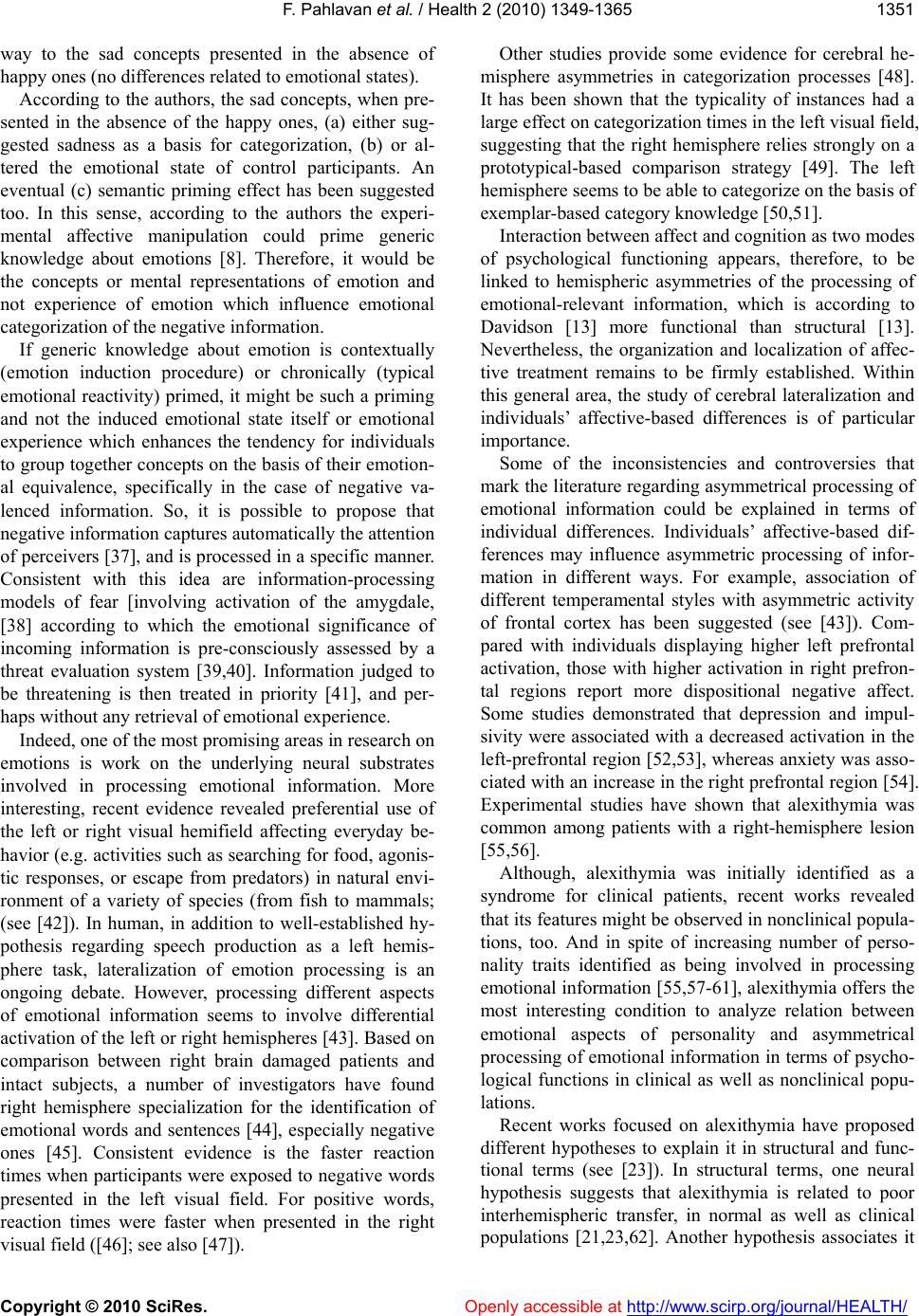 F. Pahlavan et al. / Health 2 (2010) 1349-1365 Copyright © 2010 SciRes. Openly accessible at http://www.scirp.org/journal/HEALTH/ 1351 way to the sad concepts presented in the absence of happy ones (no differences related to emotional states). According to the authors, the sad concepts, when pre- sented in the absence of the happy ones, (a) either sug- gested sadness as a basis for categorization, (b) or al- tered the emotional state of control participants. An eventual (c) semantic priming effect has been suggested too. In this sense, according to the authors the experi- mental affective manipulation could prime generic knowledge about emotions [8]. Therefore, it would be the concepts or mental representations of emotion and not experience of emotion which influence emotional categorization of the negative information. If generic knowledge about emotion is contextually (emotion induction procedure) or chronically (typical emotional reactivity) primed, it might be such a priming and not the induced emotional state itself or emotional experience which enhances the tendency for individuals to group together concepts on the basis of their emotion- al equivalence, specifically in the case of negative va- lenced information. So, it is possible to propose that negative informatio n captures au to matically th e atten tion of perceivers [37], and is processed in a specific manner. Consistent with this idea are information-processing models of fear [involving activation of the amygdale, [38] according to which the emotional significance of incoming information is pre-consciously assessed by a threat evaluation system [39,40]. Information judged to be threatening is then treated in priority [41], and per- haps without any retrieval of emotional experience. Indeed, one of the most promising areas in research on emotions is work on the underlying neural substrates involved in processing emotional information. More interesting, recent evidence revealed preferential use of the left or right visual hemifield affecting everyday be- havior (e.g. activities such as searching for food, agonis- tic responses, or escape from predators) in natural envi- ronment of a variety of species (from fish to mammals; (see [42]). In human, in addition to well-established hy- pothesis regarding speech production as a left hemis- phere task, lateralization of emotion processing is an ongoing debate. However, processing different aspects of emotional information seems to involve differential activation of the left or right hemispheres [43]. Based on comparison between right brain damaged patients and intact subjects, a number of investigators have found right hemisphere specialization for the identification of emotional words and sentences [44], especially negative ones [45]. Consistent evidence is the faster reaction times when participants were expo sed to negative words presented in the left visual field. For positive words, reaction times were faster when presented in the right visual field ([46]; see also [47]). Other studies provide some evidence for cerebral he- misphere asymmetries in categorization processes [48]. It has been shown that the typicality of instances had a large effect on categorization times in the left visual field, suggesting that the right hemisphere relies strongly on a prototypical-based comparison strategy [49]. The left hemisphere seems to be able to categorize on the basis of exemplar-based category knowledge [50,51]. Interaction between affect and cognition as two modes of psychological functioning appears, therefore, to be linked to hemispheric asymmetries of the processing of emotional-relevant information, which is according to Davidson [13] more functional than structural [13]. Nevertheless, the organization and localization of affec- tive treatment remains to be firmly established. Within this general area, the study of cerebral lateralization and individuals’ affective-based differences is of particular importance. Some of the inconsistencies and controversies that mark the literature regarding asymmetrical processing of emotional information could be explained in terms of individual differences. Individuals’ affective-based dif- ferences may influence asymmetric processing of infor- mation in different ways. For example, association of different temperamental styles with asymmetric activity of frontal cortex has been suggested (see [43]). Com- pared with individuals displaying higher left prefrontal activation, those with higher activation in right prefron- tal regions report more dispositional negative affect. Some studies demonstrated that depression and impul- sivity were associated with a decreased activation in the left-prefrontal region [52,53], whereas anxiety was asso- ciated with an increase in the right prefrontal region [54]. Experimental studies have shown that alexithymia was common among patients with a right-hemisphere lesion [55,56]. Although, alexithymia was initially identified as a syndrome for clinical patients, recent works revealed that its features might be observed in nonclinical popula- tions, too. And in spite of increasing number of perso- nality traits identified as being involved in processing emotional information [55,57-61 ], alexithymia offers the most interesting condition to analyze relation between emotional aspects of personality and asymmetrical processing of emotional information in terms of psycho- logical functions in clinical as well as nonclinical popu- lations. Recent works focused on alexithymia have proposed different hypotheses to explain it in structural and func- tional terms (see [23]). In structural terms, one neural hypothesis suggests that alexithymia is related to poor interhemispheric transfer, in normal as well as clinical populations [21,23,62]. Another hypothesis associates it 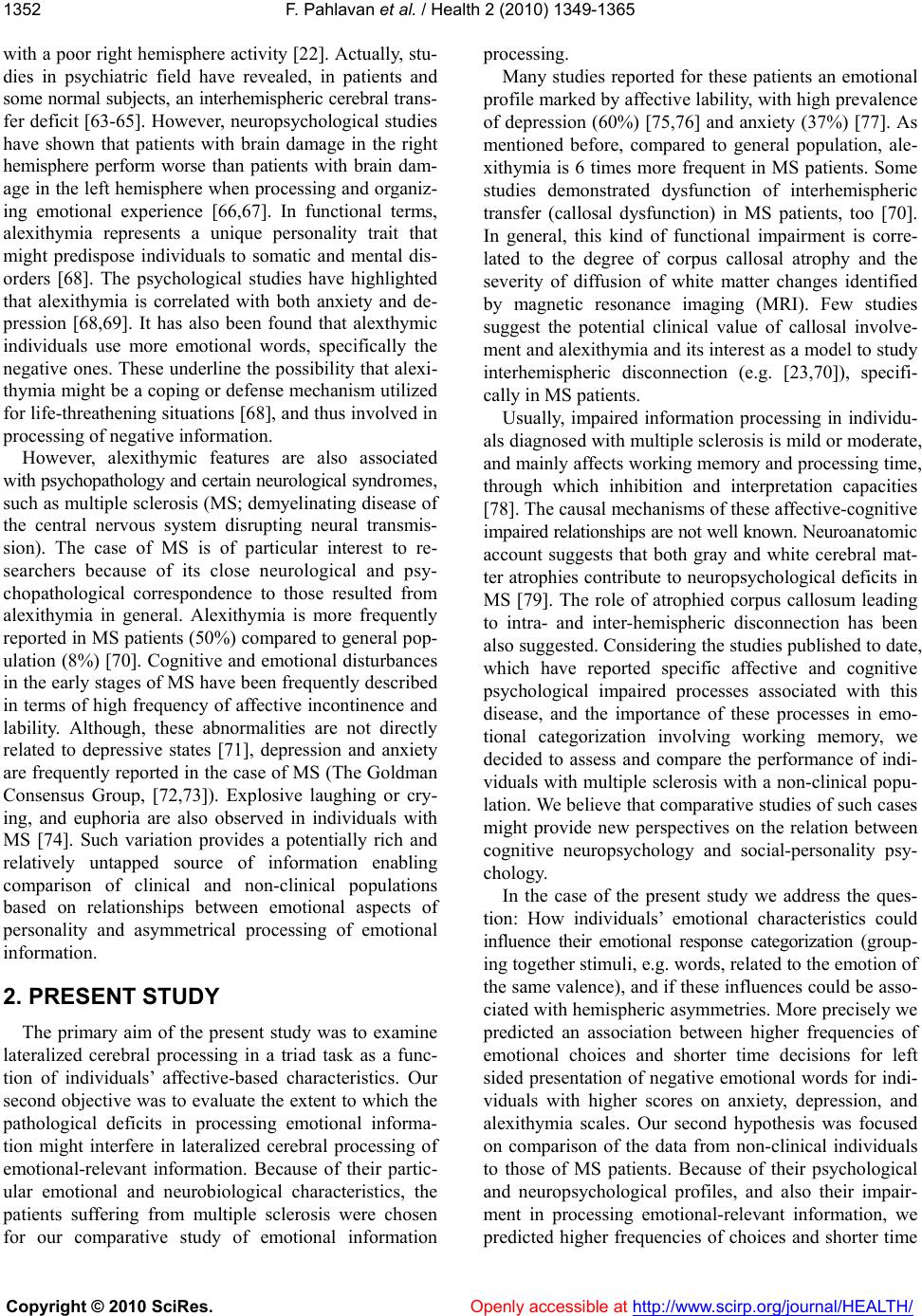 F. Pahlavan et al. / Health 2 (2010) 1349-1365 Copyright © 2010 SciRes. Openly accessible at http://www.scirp.org/journal/HEALTH/ 1352 with a poor right hemisphere activity [22]. Actually, stu- dies in psychiatric field have revealed, in patients and some normal subjects, an interhemispheric cerebral tran s- fer deficit [63-65]. However, neuropsychological studies have shown that patients with brain damage in the right hemisphere perform worse than patients with brain dam- age in the left hemisphere when processing and organiz- ing emotional experience [66,67]. In functional terms, alexithymia represents a unique personality trait that might predispose individuals to somatic and mental dis- orders [68]. The psychological studies have highlighted that alexithymia is correlated with both anxiety and de- pression [68,69]. It has also been found that alexthymic individuals use more emotional words, specifically the negative ones. These underline the possibility th at alexi- thymia might be a cop ing or defense mechanism utilized for life-threathening situations [68], and thus invo lved in processing of negative information. However, alexithymic features are also associated with psychopathology and certain neurological syndr o mes , such as multiple sclerosis (MS; demyelinating disease of the central nervous system disrupting neural transmis- sion). The case of MS is of particular interest to re- searchers because of its close neurological and psy- chopathological correspondence to those resulted from alexithymia in general. Alexithymia is more frequently reported in MS patients (50%) compared to general pop- ulation (8%) [70]. Cognitive and emotional disturbances in the early stages of MS have been frequently described in terms of high frequency of affective incontinence and lability. Although, these abnormalities are not directly related to depressive states [71], depression and anxiety are frequently reported in the case of MS (The Goldman Consensus Group, [72,73]). Explosive laughing or cry- ing, and euphoria are also observed in individuals with MS [74]. Such variation provides a potentially rich and relatively untapped source of information enabling comparison of clinical and non-clinical populations based on relationships between emotional aspects of personality and asymmetrical processing of emotional information. 2. PRESENT STUDY The primary aim of the present study was to examine lateralized cerebral processing in a triad task as a func- tion of individuals’ affective-based characteristics. Our second objective was to evaluate the exten t to which the pathological deficits in processing emotional informa- tion might interfere in lateralized cerebral processing of emotional-relevant information. Because of their partic- ular emotional and neurobiological characteristics, the patients suffering from multiple sclerosis were chosen for our comparative study of emotional information processing. Many studies reported for these patients an emotional profile marked by affective lability, with high prevalen ce of depression (60%) [75,76] and anxiety (37%) [77]. As mentioned before, compared to general population, ale- xithymia is 6 times more frequent in MS patients. Some studies demonstrated dysfunction of interhemispheric transfer (callosal dysfunction) in MS patients, too [70]. In general, this kind of functional impairment is corre- lated to the degree of corpus callosal atrophy and the severity of diffusion of white matter changes identified by magnetic resonance imaging (MRI). Few studies suggest the potential clinical value of callosal involve- ment and alexithymia and its interest as a model to study interhemispheric disconnection (e.g. [23,70]), specifi- cally in MS patients. Usually, impaired information processing in individu- als diagnosed with multiple s clerosis is mild or moderate, and mainly affects working memory and processing time, through which inhibition and interpretation capacities [78]. The causal mechanisms of these affective-cognitive i mpaired relationships are not w ell known. Neuroan a to mi c account suggests that both gray and white cerebral mat- ter atrophies contribute to neuropsycho logical deficits in MS [79]. The role of atrophied corpus callosum leading to intra- and inter-hemispheric disconnection has been also suggested. Considering the studies published to date, which have reported specific affective and cognitive psychological impaired processes associated with this disease, and the importance of these processes in emo- tional categorization involving working memory, we decided to assess and compare the performance of indi- viduals with multiple sclerosis with a non-clinical popu- lation. We believe that comparative stud ies of such cases might provide new perspectives on the relation between cognitive neuropsychology and social-personality psy- chology. In the case of the present study we address the ques- tion: How individuals’ emotional characteristics could influence their emotional response categorization (group- ing together stimuli, e.g. words, related to the emotion of the same valence), and if these influences could be asso- ciated with hemispheric asymmetries. More precisely we predicted an association between higher frequencies of emotional choices and shorter time decisions for left sided presentation of negative emotional words for indi- viduals with higher scores on anxiety, depression, and alexithymia scales. Our second hypothesis was focused on comparison of the data from non-clinical individuals to those of MS patients. Because of their psychological and neuropsychological profiles, and also their impair- ment in processing emotional-relevant information, we predicted higher frequencies of choices and shorter time 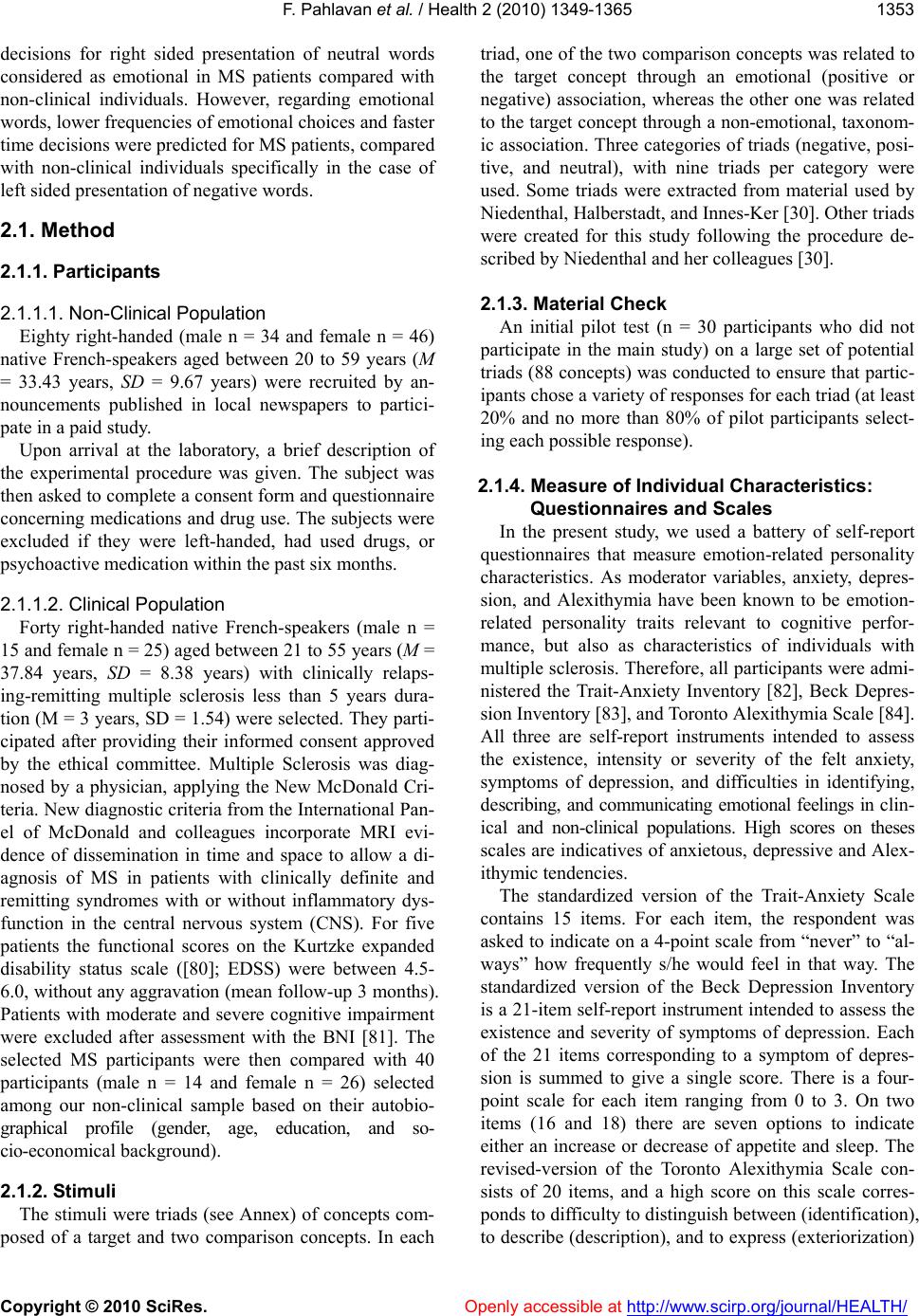 F. Pahlavan et al. / Health 2 (2010) 1349-1365 Copyright © 2010 SciRes. Openly accessible at http://www.scirp.org/journal/HEALTH/ 1353 decisions for right sided presentation of neutral words considered as emotional in MS patients compared with non-clinical individuals. However, regarding emotional words, lower frequencies of emotional choices and faster time decisions were predicted for MS patients, compared with non-clinical individuals specifically in the case of left sided presentation of negative words. 2.1. Method 2.1.1. Participant s 2.1.1.1. Non-Clinical Population Eighty right-handed (male n = 34 and female n = 46) native French-speakers aged between 20 to 59 years (M = 33.43 years, SD = 9.67 years) were recruited by an- nouncements published in local newspapers to partici- pate in a paid study. Upon arrival at the laboratory, a brief description of the experimental procedure was given. The subject was then asked to complete a consent form and questionnaire concerning medications and drug use. The subjects were excluded if they were left-handed, had used drugs, or psychoactive medi cati on wi t hin the past six m ont hs. 2.1.1.2. Clinical Population Forty right-handed native French-speakers (male n = 15 and female n = 25) aged between 21 to 55 years (M = 37.84 years, SD = 8.38 years) with clinically relaps- ing-remitting multiple sclerosis less than 5 years dura- tion (M = 3 years, SD = 1.54) were selected. They parti- cipated after providing their informed consent approved by the ethical committee. Multiple Sclerosis was diag- nosed by a physician, applying the New McDonald Cri- teria. New diagnostic criteria from the International Pan- el of McDonald and colleagues incorporate MRI evi- dence of dissemination in time and space to allow a di- agnosis of MS in patients with clinically definite and remitting syndromes with or without inflammatory dys- function in the central nervous system (CNS). For five patients the functional scores on the Kurtzke expanded disability status scale ([80]; EDSS) were between 4.5- 6.0, without any aggravation (mean follow-up 3 months). Patients with moderate and severe cognitive impairment were excluded after assessment with the BNI [81]. The selected MS participants were then compared with 40 participants (male n = 14 and female n = 26) selected among our non-clinical sample based on their autobio- graphical profile (gender, age, education, and so- cio-economical background). 2.1.2. Stimuli The stimuli were triads (see Annex) of concepts com- posed of a target and two comparison concepts. In each triad, one of the two comparison concepts was related to the target concept through an emotional (positive or negative) association, whereas the other one was related to the target concept through a non-emotional, taxono m- ic association. Three categories of triads (neg ative, posi- tive, and neutral), with nine triads per category were used. Some triads were extracted from material used by Niedenthal, Halberstadt, and Innes-Ker [30]. Other triads were created for this study following the procedure de- scribed by Niedenthal and her colleagues [30]. 2.1.3. Material Check An initial pilot test (n = 30 participants who did not participate in the main study) on a large set of potential triads (88 concepts) was conducted to ensure that partic- ipants chose a variety of responses for each triad (at least 20% and no more than 80% of pilot participants select- ing each possible response). 2.1.4. Measure of Individual Characteristics: Questionnaires and Scales In the present study, we used a battery of self-report questionnaires that measure emotion-related personality characteristics. As moderator variables, anxiety, depres- sion, and Alexithymia have been known to be emotion- related personality traits relevant to cognitive perfor- mance, but also as characteristics of individuals with multiple sclerosis. Therefore, all participan ts were admi- nistered the Trait-Anxiety Inventory [82], Beck Depres- sion Inventory [83], and Toronto Alexithymia Scale [84]. All three are self-report instruments intended to assess the existence, intensity or severity of the felt anxiety, symptoms of depression, and difficulties in identifying, describing, and communicating emotional feelings in clin- ical and non-clinical populations. High scores on theses scales are indicatives of anxietous, depressive and Alex- ithymic tendencies. The standardized version of the Trait-Anxiety Scale contains 15 items. For each item, the respondent was asked to indicate on a 4-point scale from “never” to “al- ways” how frequently s/he would feel in that way. The standardized version of the Beck Depression Inventory is a 21-item self-report instrument intended to assess the existence and severity of symptoms of depression. Each of the 21 items corresponding to a symptom of depres- sion is summed to give a single score. There is a four- point scale for each item ranging from 0 to 3. On two items (16 and 18) there are seven options to indicate either an increase or decrease of appetite and sleep. The revised-version of the Toronto Alexithymia Scale con- sists of 20 items, and a high score on this scale corres- ponds to difficulty to distinguish between (identification), to describe (description), and to express (ex teriorization) 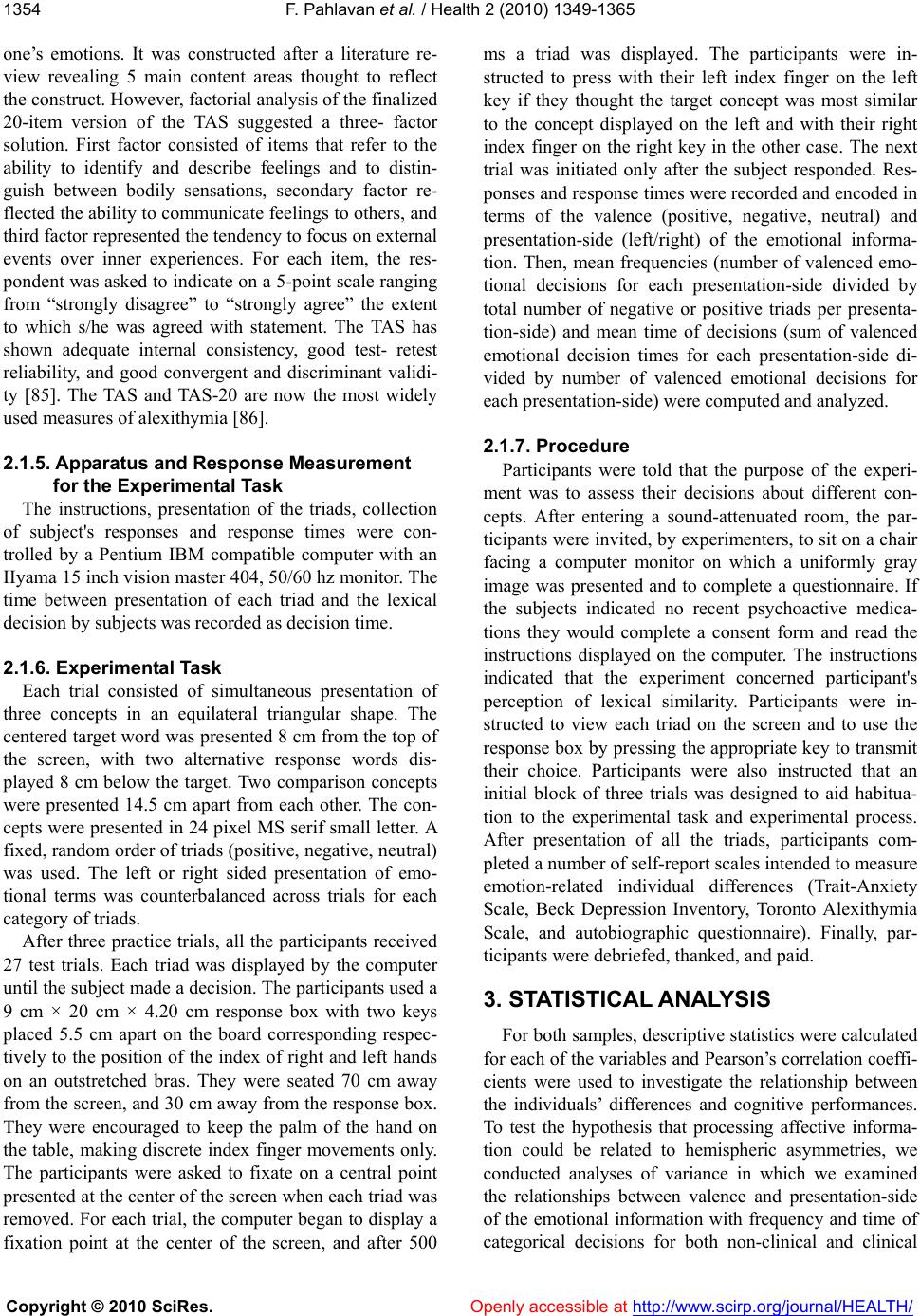 F. Pahlavan et al. / Health 2 (2010) 1349-1365 Copyright © 2010 SciRes. Openly accessible at http://www.scirp.org/journal/HEALTH/ 1354 one’s emotions. It was constructed after a literature re- view revealing 5 main content areas thought to reflect the construct. However, factorial analysis of the finalized 20-item version of the TAS suggested a three- factor solution. First factor consisted of items that refer to the ability to identify and describe feelings and to distin- guish between bodily sensations, secondary factor re- flected the ability to communicate feelings to others, and third factor represented the tend ency to focus on extern al events over inner experiences. For each item, the res- pondent was asked to indicate on a 5-point scale ranging from “strongly disagree” to “strongly agree” the extent to which s/he was agreed with statement. The TAS has shown adequate internal consistency, good test- retest reliability, and good convergent and discriminant validi- ty [85]. The TAS and TAS-20 are now the most widely used measures of alexithymia [86]. 2.1.5. Apparatus and Response Measurement for the Experimental Task The instructions, presentation of the triads, collection of subject's responses and response times were con- trolled by a Pentium IBM compatible computer with an IIyama 15 inch vision master 404, 50/60 hz monitor. The time between presentation of each triad and the lexical decision by subjects was recorded as decision time. 2.1.6. Experiment al Task Each trial consisted of simultaneous presentation of three concepts in an equilateral triangular shape. The centered target word was presented 8 cm from the top of the screen, with two alternative response words dis- played 8 cm below the target. Two comparison concepts were presented 14.5 cm apart from each other. The con- cepts were presented in 24 p ixel MS serif small letter. A fixed, random order of triads (positiv e, negative, n eutral) was used. The left or right sided presentation of emo- tional terms was counterbalanced across trials for each category of triad s. After three practice trials, all the participants received 27 test trials. Each triad was displayed by the computer until the subj ect made a d ecision. The particip an ts used a 9 cm × 20 cm × 4.20 cm response box with two keys placed 5.5 cm apart on the board corresponding respec- tively to the position of the index of right an d left hands on an outstretched bras. They were seated 70 cm away from the screen, and 30 cm away from the response box. They were encouraged to keep the palm of the hand on the table, making discrete index finger movements only. The participants were asked to fixate on a central point presented at the center of the screen when each triad was removed. For each trial, the computer began to display a fixation point at the center of the screen, and after 500 ms a triad was displayed. The participants were in- structed to press with their left index finger on the left key if they thought the target concept was most similar to the concept displayed on the left and with their right index finger on the right key in the other case. The next trial was initiated only after the subject responded. Res- ponses and response times were record ed an d encod ed in terms of the valence (positive, negative, neutral) and presentation-side (left/right) of the emotional informa- tion. Then, mean frequencies (number of valenced emo- tional decisions for each presentation-side divided by total number of negative or positive triads per presenta- tion-side) and mean time of decisions (sum of valenced emotional decision times for each presentation-side di- vided by number of valenced emotional decisions for each presentation-side) were computed and analyzed. 2.1.7. Procedure Participants were told that the purpose of the experi- ment was to assess their decisions about different con- cepts. After entering a sound-attenuated room, the par- ticipants were invited, by experimenters, to sit on a chair facing a computer monitor on which a uniformly gray image was presented and to complete a questionnaire. If the subjects indicated no recent psychoactive medica- tions they would complete a consent form and read the instructions displayed on the computer. The instructions indicated that the experiment concerned participant's perception of lexical similarity. Participants were in- structed to view each triad on the screen and to use the response box by pressing the appropriate key to transmit their choice. Participants were also instructed that an initial block of three trials was designed to aid habitua- tion to the experimental task and experimental process. After presentation of all the triads, participants com- pleted a number of self-report scales intended to measure emotion-related individual differences (Trait-Anxiety Scale, Beck Depression Inventory, Toronto Alexithymia Scale, and autobiographic questionnaire). Finally, par- ticipants were debriefed, thanked, and paid. 3. STATISTICAL ANALYSIS For both samples, descriptive statistics were calculated for each of the variables and Pearson’s correlation coeffi- cients were used to investigate the relationship between the individuals’ differences and cognitive performances. To test the hypothesis that processing affective informa- tion could be related to hemispheric asymmetries, we conducted analyses of variance in which we examined the relationships between valence and presentation-side of the emotional information with frequency and time of categorical decisions for both non-clinical and clinical 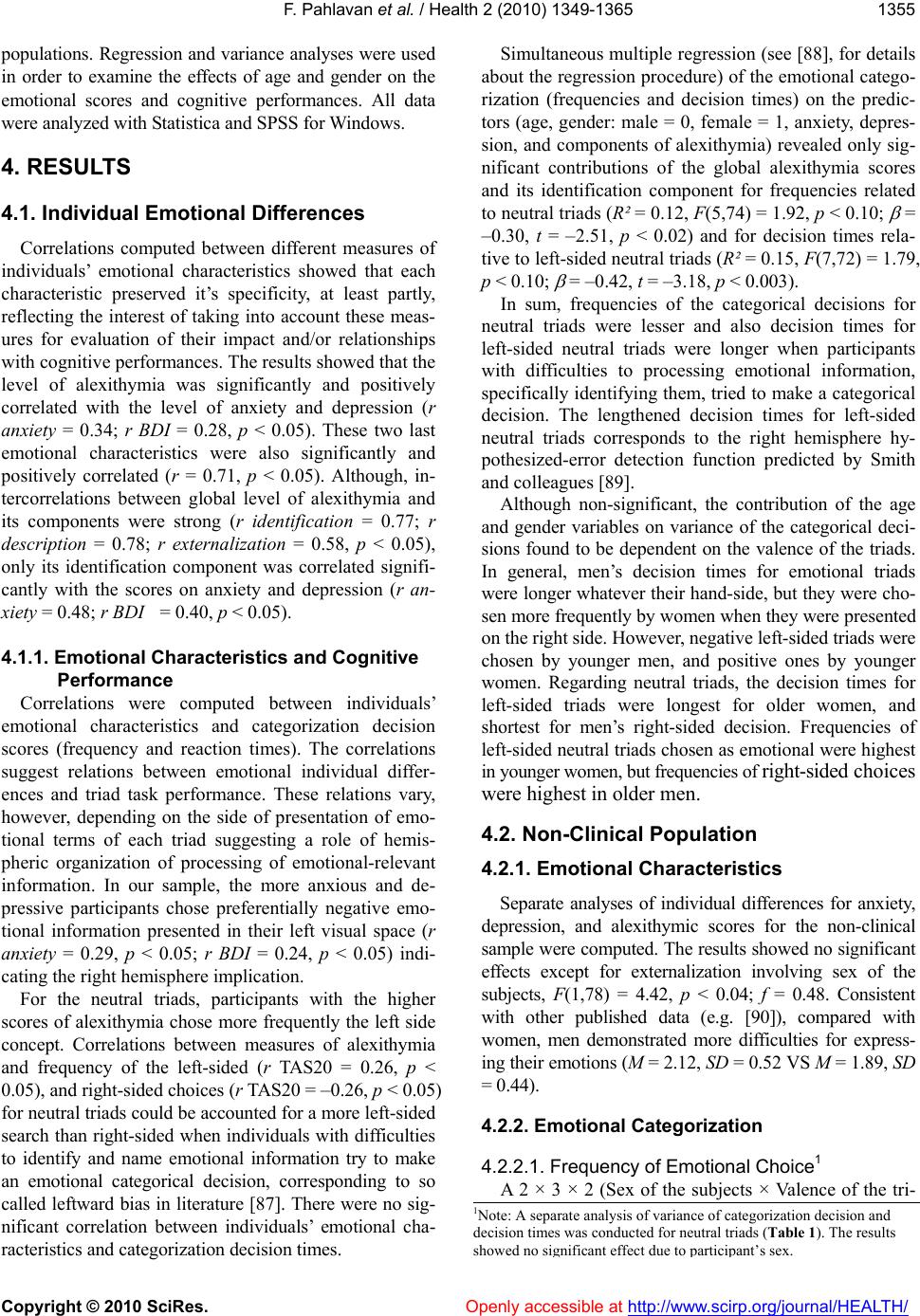 F. Pahlavan et al. / Health 2 (2010) 1349-1365 Copyright © 2010 SciRes. Openly accessible at http://www.scirp.org/journal/HEALTH/ 1355 populations. Regression and variance analyses were used in order to examine the effects of age and gender on the emotional scores and cognitive performances. All data were analyzed with Statistica and SPSS for Windows. 4. RESULTS 4.1. Individual Emotional Differences Correlations computed between different measures of individuals’ emotional characteristics showed that each characteristic preserved it’s specificity, at least partly, reflecting the interest of taking into account these meas- ures for evaluation of their impact and/or relationships with cognitive performances. The results showed that the level of alexithymia was significantly and positively correlated with the level of anxiety and depression (r anxiety = 0.34; r BDI = 0.28, p < 0.05). These two last emotional characteristics were also significantly and positively correlated (r = 0.71, p < 0.05). Although, in- tercorrelations between global level of alexithymia and its components were strong (r identification = 0.77; r description = 0.78; r externalization = 0.58, p < 0.05), only its identification component was correlated signifi- cantly with the scores on anxiety and depression (r an- xiety = 0.48; r BDI = 0.40, p < 0.05). 4.1.1. Emotional Characteristics and Cognitiv e Performance Correlations were computed between individuals’ emotional characteristics and categorization decision scores (frequency and reaction times). The correlations suggest relations between emotional individual differ- ences and triad task performance. These relations vary, however, depending on the side of presentation of emo- tional terms of each triad suggesting a role of hemis- pheric organization of processing of emotional-relevant information. In our sample, the more anxious and de- pressive participants chose preferentially negative emo- tional information presented in their left visual space (r anxiety = 0.29, p < 0.05; r BDI = 0.24, p < 0.05) indi- cating the right hemisphere implication. For the neutral triads, participants with the higher scores of alexithymia chose more frequently the left side concept. Correlations between measures of alexithymia and frequency of the left-sided (r TAS20 = 0.26, p < 0.05), and right-sided choices (r TAS20 = –0.26, p < 0.05) for neutral triads could be accounted for a more left-sided search than right-sided when individuals with difficulties to identify and name emotional information try to make an emotional categorical decision, corresponding to so called leftward bias in literature [87]. There were no sig- nificant correlation between individuals’ emotional cha- racteristics and categorization decision t imes. Simultaneous multiple regression (see [88], for details about the regression procedure) of the emotional catego- rization (frequencies and decision times) on the predic- tors (age, gender: male = 0, female = 1, anxiety, depres- sion, and components of alexithymia) revealed only sig- nificant contributions of the global alexithymia scores and its identification component for frequencies related to neutral triads (R² = 0.12, F(5,74) = 1.92, p < 0.10; = –0.30, t = –2.51, p < 0.02) and for decision times rela- tive to left-sided neutral triads (R² = 0.15, F(7,72) = 1.79, p < 0.10; = –0.42, t = –3.18, p < 0.003). In sum, frequencies of the categorical decisions for neutral triads were lesser and also decision times for left-sided neutral triads were longer when participants with difficulties to processing emotional information, specifically identifying them, tried to make a categorical decision. The lengthened decision times for left-sided neutral triads corresponds to the right hemisphere hy- pothesized-error detection function predicted by Smith and colleagues [89]. Although non-significant, the contribution of the age and gender variables on variance of the categorical deci- sions found to be dependent on the valence of the triads. In general, men’s decision times for emotional triads were longer whatever their hand-side, but they were cho- sen more frequently by women when they were presented on the right side. However, negative left-sided triads were chosen by younger men, and positive ones by younger women. Regarding neutral triads, the decision times for left-sided triads were longest for older women, and shortest for men’s right-sided decision. Frequencies of left-sided neutral triads cho sen as emotional were h ighest in younger women, but frequencies of right-sided choic es were highest in older men. 4.2. Non-Clinical Population 4.2.1. Emotional Characteristics Separate analyses of individual differences for anxiety, depression, and alexithymic scores for the non-clinical sample were computed. The results showed no significant effects except for externalization involving sex of the subjects, F(1,78) = 4.42, p < 0.04; f = 0.48. Consistent with other published data (e.g. [90]), compared with women, men demonstrated more difficulties for express- ing their emotions (M = 2.12, SD = 0.52 VS M = 1.89, SD = 0.44). 4.2.2. Emotional Categorization 4.2.2.1. Frequency of Emotional Choice1 A 2 × 3 × 2 (Sex of the subjects × Valence of the tri- 1Note: A separate analysis of variance of categorization decision and decision times was conducted for neutra l t riads (Table 1). The results showed no si g nificant effect due to p artici p ant’s sex. 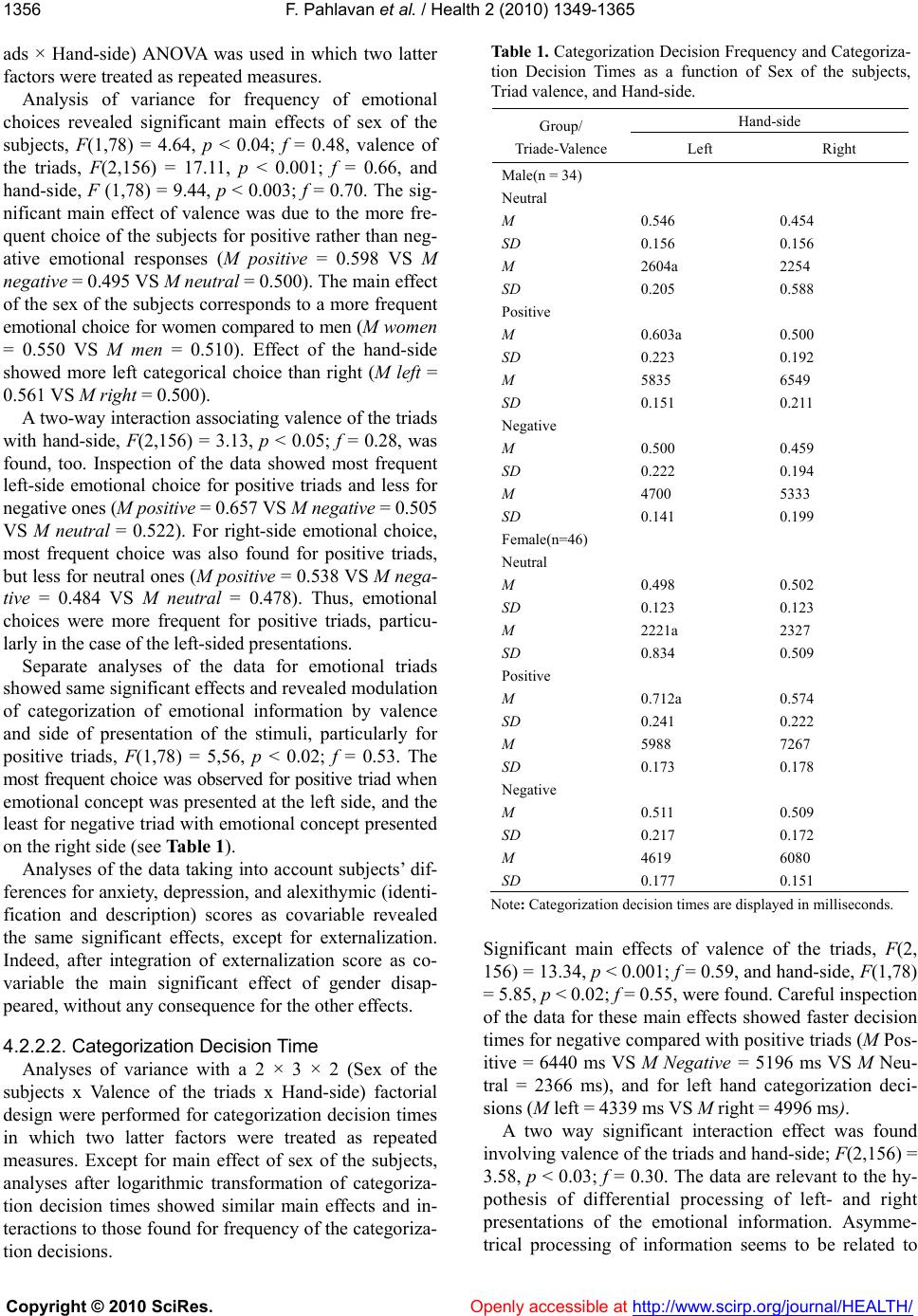 F. Pahlavan et al. / Health 2 (2010) 1349-1365 Copyright © 2010 SciRes. Openly accessible at http://www.scirp.org/journal/HEALTH/ 1356 ads × Hand-side) ANOVA was used in which two latter factors were treated as repeated measures. Analysis of variance for frequency of emotional choices revealed significant main effects of sex of the subjects, F(1,78) = 4.64, p < 0.04; f = 0.48, valence of the triads, F(2,156) = 17.11, p < 0.001; f = 0.66, and hand-side, F (1,78) = 9.44, p < 0.003; f = 0.70. The sig- nificant main effect of valence was due to the more fre- quent choice of the su bjects for positive rather than neg- ative emotional responses (M positive = 0.598 VS M negative = 0.495 VS M neutral = 0.500). The main effect of the sex of the subjects corresponds to a more frequent emotional choice for wo men compared to men (M w om en = 0.550 VS M men = 0.510). Effect of the hand-side showed more left categorical choice than right (M left = 0. 56 1 VS M right = 0.500). A two-way in teraction associating v alence of the triads with hand-side, F(2,156) = 3.13, p < 0.05; f = 0.28, was found, too. Inspection of the data showed most frequent left-side emotional choice for positive triads and less for negative ones (M positive = 0.657 VS M negative = 0 .505 VS M neutral = 0.522). For right-side emotional choice, most frequent choice was also found for positive triads, but less for neutral ones (M positive = 0.538 VS M nega- tive = 0.484 VS M neutral = 0.478). Thus, emotional choices were more frequent for positive triads, particu- larly in the case of the left-sided presentations. Separate analyses of the data for emotional triads showed same significant effects and revealed modulation of categorization of emotional information by valence and side of presentation of the stimuli, particularly for positive triads, F(1,78) = 5,56, p < 0.02; f = 0.53. The most frequent choice wa s observed for positive triad wh en emotional concept was presented at the left side, and the least for negative triad with emotional co ncept presented on the right side (see Table 1). Analyses of the data taking into account subjects’ dif- ferences for anxiety, depression, and alexithymic (identi- fication and description) scores as covariable revealed the same significant effects, except for externalization. Indeed, after integration of externalization score as co- variable the main significant effect of gender disap- peared, without an y consequence for the o ther effects. 4.2.2.2. Categorization D ecision Time Analyses of variance with a 2 × 3 × 2 (Sex of the subjects x Valence of the triads x Hand-side) factorial design were performed for categorization decision times in which two latter factors were treated as repeated measures. Except for main effect of sex of the subjects, analyses after logarithmic transformation of categoriza- tion decision times showed similar main effects and in- teractions to those fo und for frequency of the catego riza- tion decisio ns. Tab le 1. Categorization Decision Frequency and Categoriza- tion Decision Times as a function of Sex of the subjects, Triad valence, and Hand-side. Group/ Triade-Valence Hand-side Left Right Male(n = 34) Neutral M 0.546 0.454 SD 0.156 0.156 M 2604a 2254 SD 0.205 0.588 Positive M 0.603a 0.500 SD 0.223 0.192 M 5835 6549 SD 0.151 0.211 Negative M 0.500 0.459 SD 0.222 0.194 M 4700 5333 SD 0.141 0.199 Female(n=46) Neutral M 0.498 0.502 SD 0.123 0.123 M 2221a 2327 SD 0.834 0.509 Positive M 0.712a 0.574 SD 0.241 0.222 M 5988 7267 SD 0.173 0.178 Negative M 0.511 0.509 SD 0.217 0.172 M 4619 6080 SD 0.177 0.151 Note: Categorization decision times are displayed in milliseconds. Significant main effects of valence of the triads, F(2, 156) = 13.34, p < 0.001; f = 0.59, and hand-side, F(1,78) = 5.85, p < 0.02; f = 0.55, were found. Careful in spection of the data for these main effects showed faster decision times for negative compared with positive triads (M Pos- itive = 6440 ms VS M Negative = 5196 ms VS M Neu- tral = 2366 ms), and for left hand categorization deci- sions (M left = 4339 ms VS M right = 4996 ms). A two way significant interaction effect was found involving valen ce of the tr iads and ha nd-side; F(2,156) = 3.58, p < 0.03; f = 0.30. The data are relevant to the hy- pothesis of differential processing of left- and right presentations of the emotional information. Asymme- trical processing of information seems to be related to 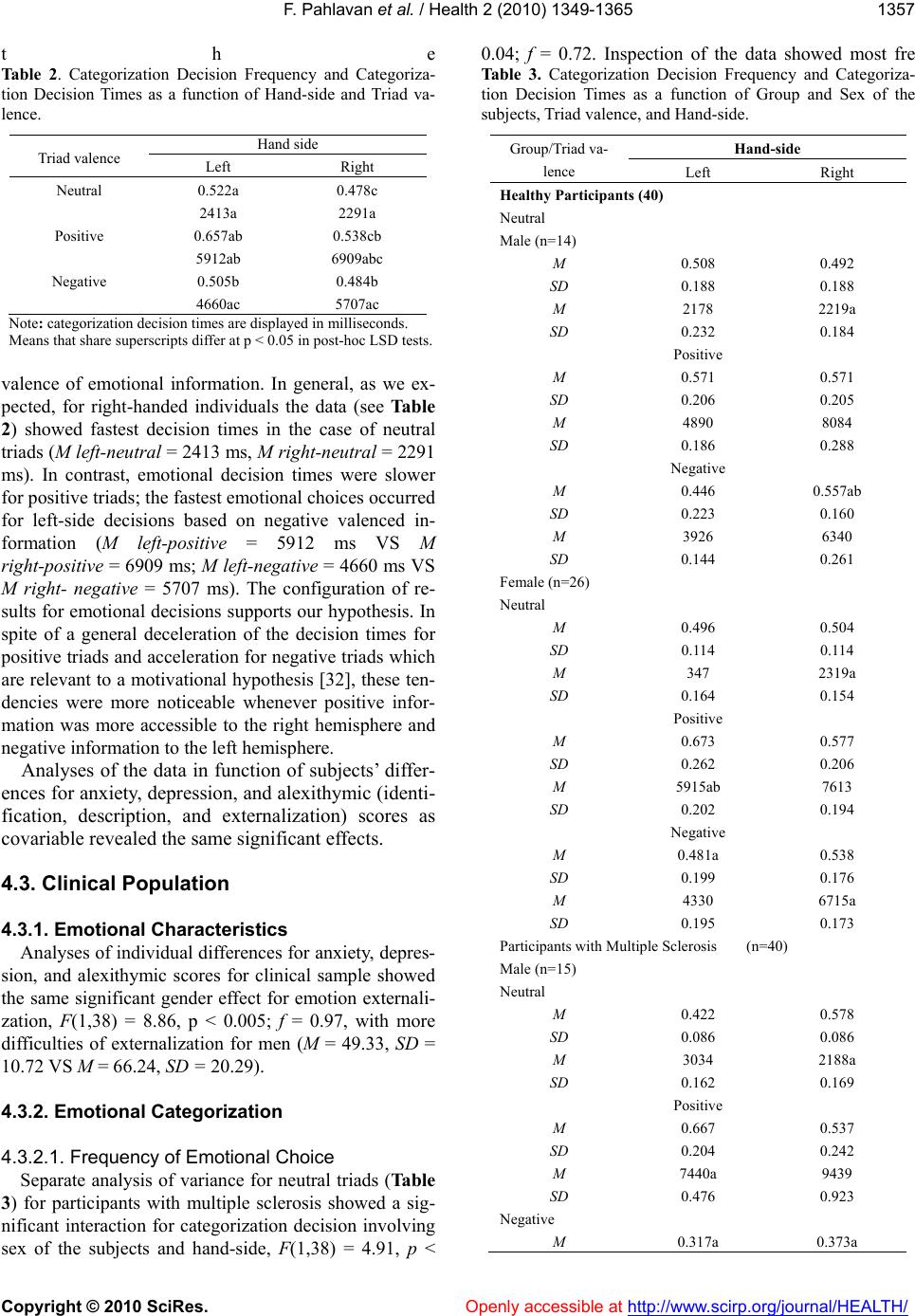 F. Pahlavan et al. / Health 2 (2010) 1349-1365 Copyright © 2010 SciRes. Openly accessible at http://www.scirp.org/journal/HEALTH/ 1357 the Table 2. Categorization Decision Frequency and Categoriza- tion Decision Times as a function of Hand-side and Triad va- lence. Triad valence Hand side Left Right Neutral 0.522a 0.478c 2413a 2291a Positive 0.657ab 0.538cb 5912ab 6909abc Negative 0.505b 0.484b 4660ac 5707ac Note: categorization decision tim es are displayed in milliseconds. Means that share superscripts differ at p < 0.05 in post-hoc LSD tests. valence of emotional information. In general, as we ex- pected, for right-handed individuals the data (see Table 2) showed fastest decision times in the case of neutral triads (M left-neutral = 2413 ms, M right-neutral = 2291 ms). In contrast, emotional decision times were slower for positive triads; the fastest emotional choices occu rred for left-side decisions based on negative valenced in- formation (M left-positive = 5912 ms VS M right-positive = 6909 ms; M left-negative = 4660 ms VS M right- negative = 5707 ms). The configuration of re- sults for emotional decisions supports our hypothesis. In spite of a general deceleration of the decision times for positive triads and acceleration for negative triads which are relevant to a motivational hypothesis [32], these ten- dencies were more noticeable whenever positive infor- mation was more accessible to the right hemisphere and negative information to the left hemisphere. Analyses of the data in function of subjects’ differ- ences for anxiety, depression, and alexithymic (identi- fication, description, and externalization) scores as covariable revealed the same significant effects. 4.3. Clinical Population 4.3.1. Emotional Characteristics Analyses of individual d ifferences for anxiety, depres- sion, and alexithymic scores for clinical sample showed the same significant gender effect for emotion externali- zation, F(1,38) = 8.86, p < 0.005; f = 0.97, with more difficulties of externalization for men (M = 49.33, SD = 10. 7 2 VS M = 66.24, SD = 20.29). 4.3.2. Emotional Categorization 4.3.2.1. Frequency of Emotional Choice Separate analysis of variance for neutral triads (Table 3) for participants with multiple sclerosis showed a sig- nificant interaction for categorization decision involving sex of the subjects and hand-side, F(1,38) = 4.91, p < 0.04; f = 0.72. Inspection of the data showed most fre Table 3. Categorization Decision Frequency and Categoriza- tion Decision Times as a function of Group and Sex of the subjects, Triad val ence, a n d Hand-side. Group/Triad va- lence Hand-side Left Right Healthy Participants (40) Neutral Male (n=14) M 0.508 0.492 SD 0.188 0.188 M 2178 2219a SD 0.232 0.184 Positive M 0.571 0.571 SD 0.206 0.205 M 4890 8084 SD 0.186 0.288 Negative M 0.446 0.557ab SD 0.223 0.160 M 3926 6340 SD 0.144 0.261 Female (n=26) Neutral M 0.496 0.504 SD 0.114 0.114 M 347 2319a SD 0.164 0.154 Positive M 0.673 0.577 SD 0.262 0.206 M 5915ab 7613 SD 0.202 0.194 Negative M 0.481a 0.538 SD 0.199 0.176 M 4330 6715a SD 0.195 0.173 Participants with Multiple Sclerosis (n=40) Male (n=15) Neutral M 0.422 0.578 SD 0.086 0.086 M 3034 2188a SD 0.162 0.169 Positive M 0.667 0.537 SD 0.204 0.242 M 7440a 9439 SD 0.476 0.923 Negative M 0.317a 0.373a  F. Pahlavan et al. / Health 2 (2010) 1349-1365 Copyright © 2010 SciRes. Openly accessible at http://www.scirp.org/journal/HEALTH/ 1358 SD 0.291 0.237 M 4201 6280 SD 1.701 1.233 Female (n=25) Neutral M 0.511 0.489 SD 0.140 0.140 M 2265 2460a SD 0.175 0.199 Positive M 0.640 0.640 SD 0.315 0.252 M 5635ab 9268 SD 0.931 0.191 Negative M 0.410 0.344ab SD 0.269 0.147 M 4192 4820a SD 1.376 0.720 Note: categorization decision times are displayed in millseconds. Means in the same row that do not share superscripts differ at p<.05 in post-hoc LSD tests. quent right-side and less left-side choices for men (M left-side = 0.422 VS M right-side = 0.578; p < 0.02). Reverse tendencies were found for women (M left-side = 0.511 VS M right-side = 0.489). It seemed false alarm were significantly more frequent for men in the case of the right-sided information, whereas women did the same for left-sided ones. Analysis of variance (Sex of the subjects 2 × Valence of the triads 3 × Hand-side 2) for frequency of emotional choices revealed significant main effects of valence of the triads, F(2,76) = 22.72, p < 0.0001; f = 1.10, which was due to the more frequent choices for positive or neutral rather than negative emotional responses (M pos- itive = 0.621 VS M negative = 0.361 VS M neutral = 0.500). A three-way interactio n associating sex of the subjects with valence of the triads and hand-side, F(2,76) = 3.18, p < 0.05; f = 0.41, was found, too. Inspection of the data revealed for men most frequent left-side emotional choices for positive triads and less frequent emotional choices for negative ones (Positive: M left-side = 0.667 VS M right-side = 0.537; Negative: M left-side = 0.317 VS M right-side = 0.373. Neutral: M left-side = 0.422. VS M right-side = 0.578). For women, we did not find any differences related to hand-side for positive triads. However, women made relatively more categorical deci- sions for left-sided negative and neutral information (Positive: M left-side = 0.640 VS M right-side = 0.640; Negative: M left-side = 0.410 VS M right-side = 0.344. Neutral: M left-side = 0.511 VS M right-side = 0.489). Thus, emotional choices were more frequent for positive triads, particularly for men in the case of the left-sided presentations, in volving right hemisphere activation. For negative triads, men’s left-sided and women’s right- sided were least choices. Analyses of the data in function of subjects’ differ- ences for anxiety, depression, and alexithymic (identifi- cation, description, and externalization) scores as cova- riable revealed the same significant effects. 4.3.2.2. Categorization D ecision Time Analyses of variance performed for categorization de- cision times after logarithmic transformation of the data showed significant main effects of valence of the triads, F(2,76) = 9.37, p < 0.001; f = 0.70, and hand-side, F(1,38) = 6.45, p < 0.02; f = 0.82, and also a significant interaction effect involving same variables, F(2,76) = 5.17, p < 0.01; f = 0.52. Inspection of the data for these main effects showed faster decision times for negative compared with positive triads (M Negative = 4874 ms VS M Positive = 7946 ms VS M Neutral = 2487 ms), and for left hand compared with right hand categoriza- tion decisions (M left = 4461 ms VS M right = 5743 ms). A significant interaction effect involving valence of the triads and hand-side was observed concerning the hypothesis of asymmetrical processing of information dependent on the valence of emotional information. In general, as we expected, for right-handed individuals the data (see Ta bl e 4) showed fastest decision times in the case of neutral triads (M left-sided = 2649 ms, M right- sided = 2323 ms). For emotional decision times, right- sided decision were the slowest, specifically in the case of positive triads (M left-positive = 6538 ms VS M right-positive = 9353 ms; M left-negative = 4197 ms VS M right-negative = 5550 ms). The data’s directions for emotional decisions was similar to that of the general population in the present study, specifically when posi- tive information was more accessible to the right he- misphere and negative information to the left hemis- phere. Analyses of the data in function of subjects’ differ- ences for anxiety, depression, and alexithymic (identifi- cation, description, and externalization) scores as cova- riable revealed the same significant effects. 4.4. Comparative Analyses In order to compare performance of participants with multiple sclerosis with the general population, we conducted a separate analysis comparing 40 con- trol participants matched on sex, age, and so- cio-economical profile with those participants with multiple sclerosis.  F. Pahlavan et al. / Health 2 (2010) 1349-1365 Copyright © 2010 SciRes. Openly accessible at http://www.scirp.org/journal/HEALTH/ 1359 4.4.1. Emotional Characteristics Analyses of individual d ifferences for anxiety, depres- sion, and alexithymic scores comparing healthy partici- Table 4. Categorization Decision Frequency and Categoriza- tion Decision Times as a function of Group of the subjects, Hand-side, and Triad valence. Group/Triad va- lence Hand-side Left Right Healthy subjects Neutral 0.502 0.498 2262 2269 Positive 0.622 0.574 5402bc 7848abc Negative 0.464ab 0.548ab 4128bc 6528ac Participants with Sclerosis Neutral 0.467 0.533 2649 2324 Positive 0.653 0.588 6538a 9354ab Negative 0.363a 0.359b 4197a 5550ab Note: Categorization decision times are displayed in milliseconds. Means that share superscripts differ at p < 0.05 in post-hoc LSD tests. pants with those with multiple sclerosis showed signifi- cantly higher levels of anxiety, F(1,76) = 8.43, p < 0.005; f = 0.67; M control = 37.51 VS M sclerosis = 44.35, and alexithymic scores, F(1,76) = 16.09, p < .0001; f = 0.56; M control = 43.38 VS M sclerosis = 52.31, for the clini- cal group. Concerning alexithymic values, although in both groups there were no differences between men and women in terms of difficulties to identify emotions, F(1, 76) = 20.31, p < 0.0001; f = 1.04; M control = 14.01 VS M sclerosis = 19.25, for externalization of emotions in addition to main effects related to participants’ sex and health, a significant two-way interaction involving both variables is found, F(1,76) = 10.69, p < 0.002; f = 0.75. Compared to women, men of the non-clinical sub-sample experience more difficulties to express their emotion (M men = 17.14, SD = 3.40 VS M women = 14.92, SD = 3.53). A reversed trend is observed for the clinical group: Women more than men find difficult to express their emotions (M men = 49.33, SD = 10.71 VS M women = 66.24, SD = 20.29). No significant main effects or interaction were found for the scores on de- pression. 4.4.2. Emotional Categorization 4.4.2.1. Frequency of Emotional Choice 1 For emotional triads, a 2 × 2 × 3 × 2 (Sex of the sub- jects × Group of the subjects × Valence of the triads × Hand-side) ANOVA was used in which two latter factors were treated as repeated measures. Analysis of variance for frequency of emotional choices revealed significant main effects of valence of the triads, F(2,152) = 27.41, p < 0.001; f = 0.85, and its interaction with group of the subj ects, F(2,15 2) = 7.14, p < 0.002; f = 0.43. The significant main effect of valence was due to the most frequent choices of the subjects for positive rather than negative emotional responses (M positive = 0.610 VS M negative = 0.433 VS M neutral = 0.500). A two-way interaction associating valence of the tri- ads with group of the subjects, corresponding to the most frequent emotional choices for positive triads and least for negative ones was observed in the case of the pa rtic- ipants with multiple sclerosis (M positive = 0.621 VS M negative = 0.361 VS M neutral = 0.500) compared to healthy ones (M p ositive = 0.598 VS M negative = 0.506 VS M neutral = 0.500). In fact, differences between non-clinical and clinical participants were significant only for negative choices, F(1,76) = 13.27, p < 0.0005; f = 0.82, M control = 0.506 VS M sclerosis = 0.361. 4.4.2.2. Categorization D ecision Time A 2 × 2 × 3 × 2 (Sex of the subjects x Group of the subjects x Valence of the triads x Hand-side) factorial analysis was performed for categorization decision times in which the two latter factors were treated as repeated measures. Analyses after logarithmic transformation of categorization decision times showed in addition to the main effects of valence of the triads, F(2,152) = 8.83, p < 0.0002; f = 0.48, and hand-side, F(1,76) = 7.59, p < 0.008; f = 0.63, two two-way interactions, F(2,152) = 9.47, p < 0.0001; f = 0.50; F(1,76) = 5.06, p < 0.03; f = 0.52, and a three-way, F(2,152) = 5.23, p < 0.007; f = 0.35, involving gr oup of the subjects and the two former variables. Inspection of the data showed longest time decisions for positive information (M positive = 7286 ms VS M negative = 5101 ms VS M neutral = 2376 ms), right-sided information (M right-side = 5645 ms VS M left-side = 4196 ms), specifically for participants with multiple sclerosis in terms of valenced information (Mul- tiple sclerosis: M positive = 7946 ms VS M negative = 4874 ms VS M neutral = 2187 ms; Control: M positive = 6625 ms VS M negative = 5325 ms VS M neutral = 2265 ms), or its presentation side (Multiple sclerosis: M right-side = 5743 ms VS M left-side = 4461 ms; Control: M right-side = 5548 ms VS M left-side = 3931 ms). A three-way interaction showed that compared with non-clinical population those from clinical sample took more time to make their decisions in th e case of the pos- itive and neutral triads, with the longest decision times for right-sided positive information (Right-side: M con-  F. Pahlavan et al. / Health 2 (2010) 1349-1365 Copyright © 2010 SciRes. Openly accessible at http://www.scirp.org/journal/HEALTH/ 1360 trol = 7848 ms VS M sclerosis = 9353 ms; Left-side: M control = 5402 ms VS M sclerosis = 6537 ms), and the fastest time decisions for right-sided neutral ones (Right-side: M control = 2268 ms VS M sclerosis = 2323 ms; Left-side: M control = 2262 ms VS M sclerosis = 2649 ms). The most interesting effect was observed in the case of negative triads. Indeed, although there were no differences between healthy participants and multiple sclerosis patients when processing left-sided negative information (M control = 4127 ms VS M sclerosis = 4197 ms), in the case of the right-sided negative infor- mation participants with multiple sclero sis took less time to make their emotional decision (M control = 6527 ms VS M sclerosis = 5550 ms, see Table 4). Thus, although participants with multiple sclerosis needed much more time to make their decision about categorization of emotional information, when facing negative information they were relatively rapid. This effect could be interpreted as a consequence of their disease and the worries it generates, in which case a negative correlation between anxiety or depression scores and frequencies and time decisions for negative information would be expected. Nevertheless, the results of our study reveal rather positive and non sig- nificant correlations between these variables. 5. DISCUSSION Our data are consistent with previous studies, showing a) right hemisphere specialization for the categorization of emotional concepts (e.g. [44]), especially negative ones (e.g. [45]) in general population and in a sample of pa- tients suffering from multiple sclerosis. In addition, our data provide b) evidence for asymmetrical processing of emotional information and bring some methodological insights related to measurement of negative-valenced information processing, suggestion correspondence be- tween valenced information (positive/negative) and their presentation-side (left/right). As a matter of fact, the lack of differential processing of negative information in the absence of positive ones in some studies could be ex- plained in terms of the lack of those types of correspon- dence (e.g. [30,35,36]). Nevertheless, they show, for both populations, c) no gender-related differences re- garding individuals’ emotional characteristics, specifi- cally in terms of alexithymia features (e.g. [56]). On the basis of these findings our hypothesis that emotion-related individual differences could modulate processing of affective information is partially supported. In accordance with previous studies, analyses show that dimensions relevant to emotional disorders are generally associated with asymmetrical categorization, with slow left-sided decisions, particularly in the case of negative information. Anxious or/and alexithymic people seemed to solicit preferentially right hemisphere resources, c au s in g slower treatment of right-sided negative stimuli, except in the clinical sample. Indeed, participants with multiple sclerosis treated right-sided negative information faster than non-clinical participants. Two different but related explanations could be proposed to explain this effect. First, people with multiple sclerosis may rely first on left hemisphere activation for processing emotional informa- tion regardless of the valence of the information. Second, we could imagine that this preferentially activation is due to their general negative emot i onal stat e. Our analyses of variance showed that people develop some preferential processes for categorization decisions, which result in longer decision times for preferred infor- mation (positive information, [32]). However, even tho ugh participants preferred , in general, to us e positive info rma- tion as the basis of their categorization, they chose more left-sided than right-sided po sitive emotional alternatives. At the same time, these left preferential decisions were faster than right-sided decisions. When participants had to choose between emotional or non-emotional alterna- tives they showed the same tendencies, more frequent and faster left-sided emotional decisions. The processing of emotional information, specifically positive informa- tion seemed to be more efficient whenever it was access- ible to the right hemisphere. This preferential processing seems to vary depending on gender of the individuals. Women compared to men chose more frequently emotional information for making categorical decisions, but they took more time to make these decisions. Regarding gender, we noticed exactly the same tendencies in clinical populatio n inv estigated in present study. The main finding of the present study was that there exists patterns of hemispheric asymmetry that vary sys- tematically as an interactive function of the valence of emotional information involved in categorical decisions, and the spatial presentation of this information (left- or right side), resulting in more or less accessibility of in- formation to the left or right hemisphere. Additionally, the results showed a contribution of certain individual emotional characteristics to the organization of these patterns. The cen tral finding regarding hemispheric late- rality was that the asymmetry emerged from longer processing for the right side decisions (stimuli/response) and shorter processing for left side, thus from more ac- cessibility of the information for the right hemisphere than the left, except in the case of neutral triads. The slowest and the fastest decision s were respectively f ound for positive and neutral right-sided triads, supporting a motivational hypothesis, according to which people are motivated to search and preserve their positive feeling s . Taken together, the results concerning individuals’ 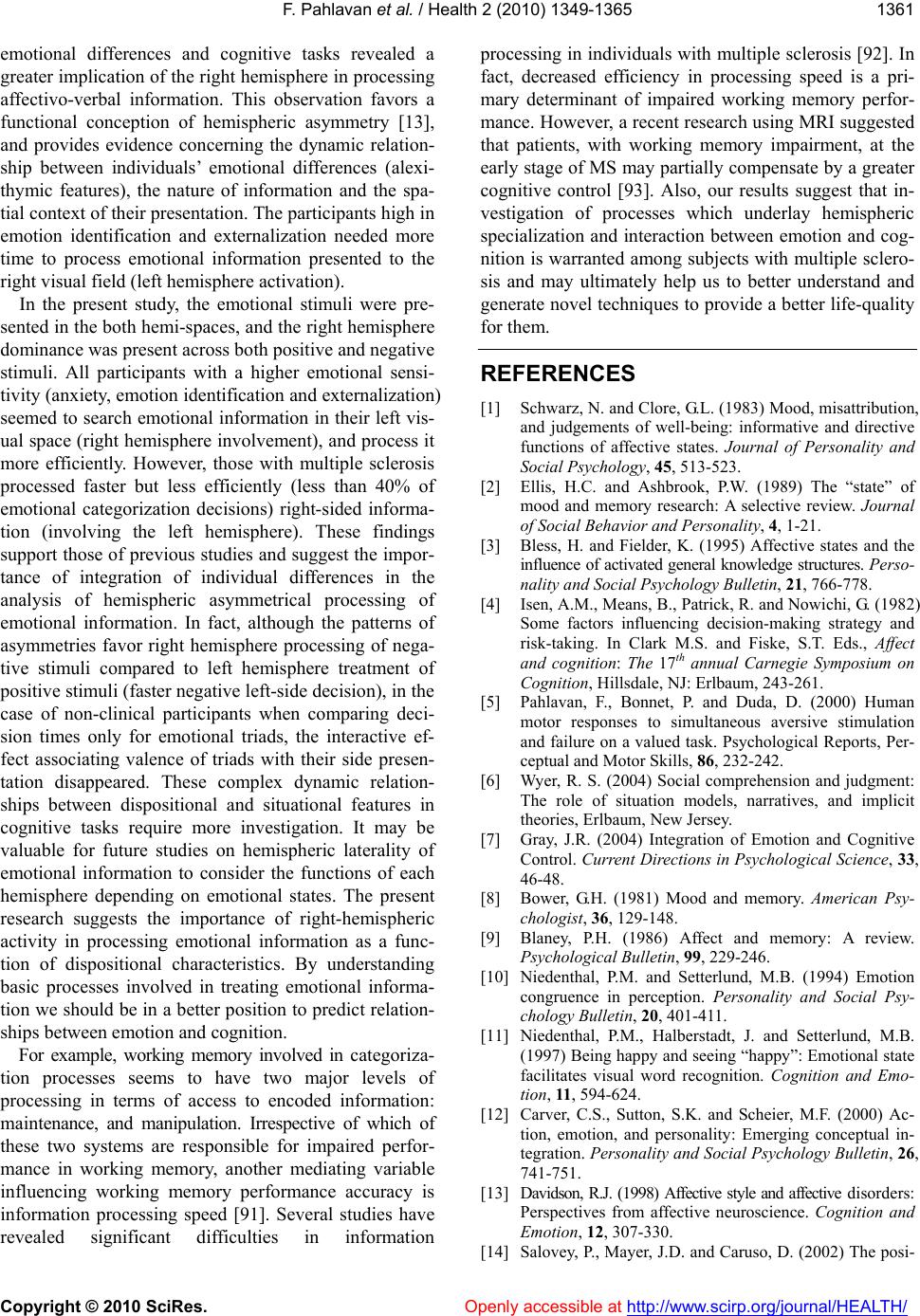 F. Pahlavan et al. / Health 2 (2010) 1349-1365 Copyright © 2010 SciRes. Openly accessible at http://www.scirp.org/journal/HEALTH/ 1361 emotional differences and cognitive tasks revealed a greater implication of the right hemisphere in processing affectivo-verbal information. This observation favors a functional conception of hemispheric asymmetry [13], and provides evidence concerning the dynamic relation- ship between individuals’ emotional differences (alexi- thymic features), the nature of information and the spa- tial context of their presentation. The participants high in emotion identification and externalization needed more time to process emotional information presented to the right visual field (left hemisphere activation). In the present study, the emotional stimuli were pre- sented in the both hemi-spaces, and the right hemisphere dominance was present across both positiv e and neg ativ e stimuli. All participants with a higher emotional sensi- tivity (anxiety, emotion id entificatio n and externalization) seemed to search emotional information in their left vis- ual space (right hemisphere involvement), and process it more efficiently. However, those with multiple sclerosis processed faster but less efficiently (less than 40% of emotional categorization decisions) right-sided informa- tion (involving the left hemisphere). These findings support those of previous studies an d suggest the impor- tance of integration of individual differences in the analysis of hemispheric asymmetrical processing of emotional information. In fact, although the patterns of asymmetries favor right hemisphere processing of nega- tive stimuli compared to left hemisphere treatment of positive stimuli (faster negative left-side decisio n), in the case of non-clinical participants when comparing deci- sion times only for emotional triads, the interactive ef- fect associating valence of triads with their side presen- tation disappeared. These complex dynamic relation- ships between dispositional and situational features in cognitive tasks require more investigation. It may be valuable for future studies on hemispheric laterality of emotional information to consider the functions of each hemisphere depending on emotional states. The present research suggests the importance of right-hemispheric activity in processing emotional information as a func- tion of dispositional characteristics. By understanding basic processes involved in treating emotional informa- tion we should be in a better pos ition to predict relation- ships between emotion and cogn ition. For example, working memory involved in categoriza- tion processes seems to have two major levels of processing in terms of access to encoded information: maintenance, and manipulation. Irrespective of which of these two systems are responsible for impaired perfor- mance in working memory, another mediating variable influencing working memory performance accuracy is information processing speed [91]. Several studies have revealed significant difficulties in information processing in individuals with multiple sclerosis [92]. In fact, decreased efficiency in processing speed is a pri- mary determinant of impaired working memory perfor- mance. However, a recent research using MRI suggested that patients, with working memory impairment, at the early stage of MS may partially compensate by a greater cognitive control [93]. Also, our results suggest that in- vestigation of processes which underlay hemispheric specialization and interaction between emotion and cog- nition is warranted among subjects with multiple sclero- sis and may ultimately help us to better understand and generate novel techniques to provid e a better life-quality for them. REFERENCES [1] Schwarz, N. and Clore, G.L. (1983) Mood, misattribution, and judgements of well-being: informative and directive functions of affective states. Journal of Personality and Soci al Psyc hology, 45, 513-523. [2] Ellis, H.C. and Ashbrook, P.W. (1989) The “state” of mood and memory research: A selective review. Journal of Social Behavior and Personality, 4, 1-21. [3] Bless, H. and Fielder, K. (1995) Affective states and the influence of activated general knowledge structures. Perso- nality and Social Psychology Bulletin, 21, 766-778. [4] Isen, A.M., Means, B., Patrick, R. and Nowichi, G. (1982) Some factors influencing decision-making strategy and risk-taking. In Clark M.S. and Fiske, S.T. Eds., Affect and cognition: The 17th annual Carnegie Symposium on Cognition, Hillsdale, NJ: Erlbaum, 243-261. [5] Pahlavan, F., Bonnet, P. and Duda, D. (2000) Human motor responses to simultaneous aversive stimulation and failure on a valued task. Psychological Reports, Per- ceptual and Motor Skills, 86, 232-242. [6] Wyer, R. S. (2004) Social comprehension and judgment: The role of situation models, narratives, and implicit theories, Erlbaum, New Jersey. [7] Gray, J.R. (2004) Integration of Emotion and Cognitive Control. Current Directions in Psychological Science, 33, 46-48. [8] Bower, G.H. (1981) Mood and memory. American Psy- chologist, 36, 129-148. [9] Blaney, P.H. (1986) Affect and memory: A review. Psychological Bulletin, 99, 229-246. [10] Niedenthal, P.M. and Setterlund, M.B. (1994) Emotion congruence in perception. Personality and Social Psy- chology Bulletin, 20, 401-411. [11] Niedenthal, P.M., Halberstadt, J. and Setterlund, M.B. (1997) Being happy and seeing “happy”: Emotional state facilitates visual word recognition. Cognition and Emo- tion, 11, 594-624. [12] Carver, C.S., Sutton, S.K. and Scheier, M.F. (2000) Ac- tion, emotion, and personality: Emerging conceptual in- tegration. Personality and Social Psychology Bulletin, 26, 741-751. [13] Davidson, R.J. (1998) Affective style and affective di so rd er s: Perspectives from affective neuroscience. Cognition and Emotion, 12, 307-330. [14] Salovey, P., Mayer, J.D. and Caruso, D. (2002) The posi- 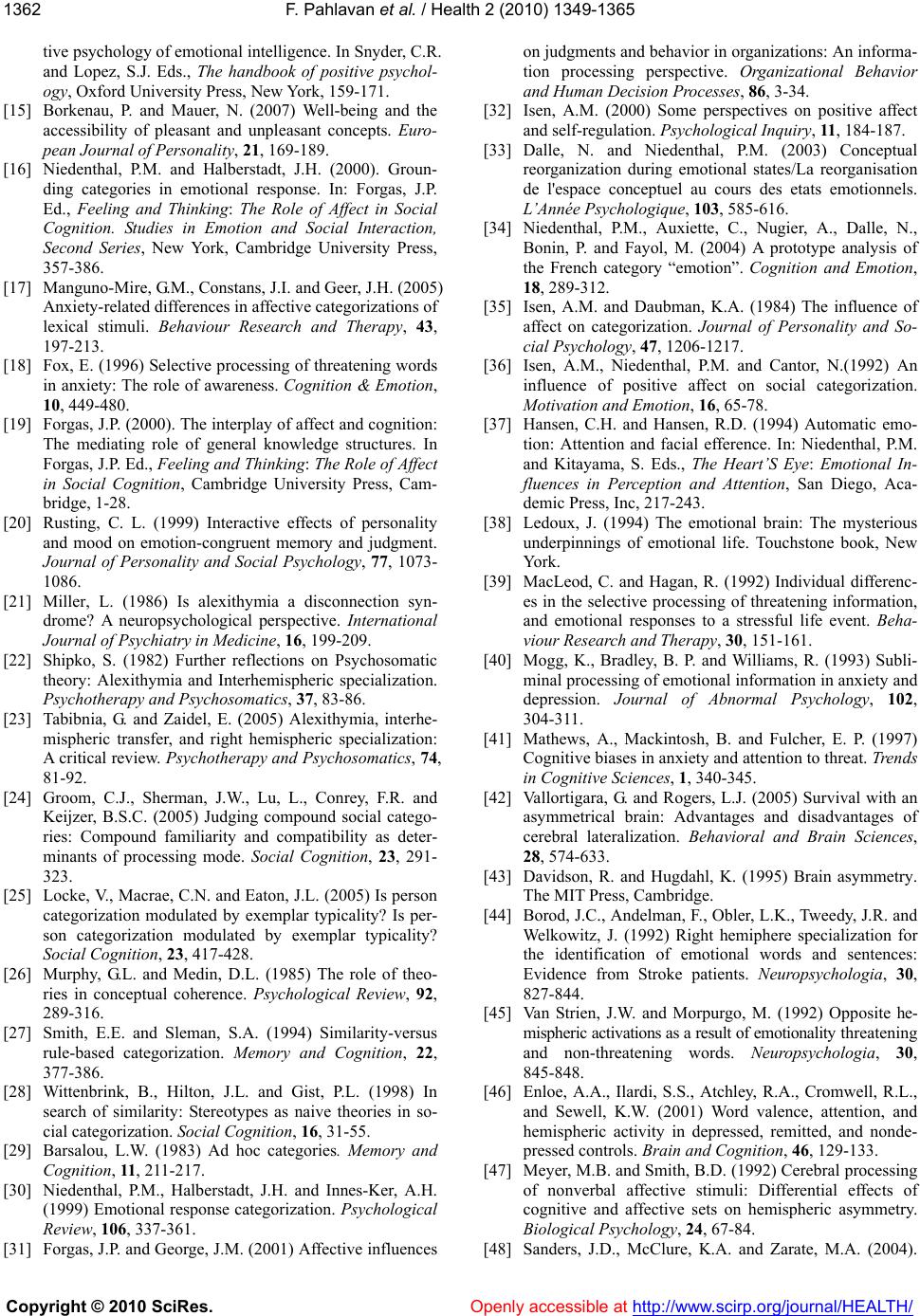 F. Pahlavan et al. / Health 2 (2010) 1349-1365 Copyright © 2010 SciRes. Openly accessible at http://www.scirp.org/journal/HEALTH/ 1362 tive psychology of emotional intelligence. In Snyder, C.R. and Lopez, S.J. Eds., The handbook of positive psychol- ogy, Oxford University Press, New York, 159-171. [15] Borkenau, P. and Mauer, N. (2007) Well-being and the accessibility of pleasant and unpleasant concepts. Euro- pean Journal of Personality, 21, 169-189. [16] Niedenthal, P.M. and Halberstadt, J.H. (2000). Groun- ding categories in emotional response. In: Forgas, J.P. Ed., Feeling and Thinking: The Role of Affect in Social Cognition. Studies in Emotion and Social Interaction, Second Series, New York, Cambridge University Press, 357-386. [17] Manguno-Mire, G. M., Constans, J.I. and Geer, J.H. (2005) Anxiety-related differences in affective categorizations of lexical stimuli. Behaviour Research and Therapy, 43, 197-213. [18] Fox, E. (1996) Selective processing of threatening words in anxiety: The role of awareness. Cognition & Emotion, 10, 449-480. [19] Forgas, J.P. (2000). The interplay of affect and cognition: The mediating role of general knowledge structures. In Forgas, J.P. Ed., Feeling and Thinking: The Role of Affect in Social Cognition, Cambridge University Press, Cam- bridge, 1-28. [20] Rusting, C. L. (1999) Interactive effects of personality and mood on emotion-congruent memory and judgment. Journal of Personality and Social Psychology, 77, 1073- 1086. [21] Miller, L. (1986) Is alexithymia a disconnection syn- drome? A neuropsychological perspective. International Journal of Psychiatry in Medicine, 16, 199-209. [22] Shipko, S. (1982) Further reflections on Psychosomatic theory: Alexithymia and Interhemispheric specialization. Psychotherapy and Psychosomatics, 37, 83-86. [23] Tabibnia, G. and Zaidel, E. (2005) Alexithymia, interhe- mispheric transfer, and right hemispheric specialization: A critical review. Psychotherapy and Psychosomatics, 74, 81-92. [24] Groom, C.J., Sherman, J.W., Lu, L., Conrey, F.R. and Keijzer, B.S.C. (2005) Judging compound social catego- ries: Compound familiarity and compatibility as deter- minants of processing mode. Social Cognition, 23, 291- 323. [25] Locke, V., Macrae, C.N. and Eaton, J.L. (2005) Is person categorization modulated by exemplar typicality? Is per- son categorization modulated by exemplar typicality? Social Cognition, 23, 417-428. [26] Murphy, G.L. and Medin, D.L. (1985) The role of theo- ries in conceptual coherence. Psychological Review, 92, 289-316. [27] Smith, E.E. and Sleman, S.A. (1994) Similarity-versus rule-based categorization. Memory and Cognition, 22, 377-386. [28] Wittenbrink, B., Hilton, J.L. and Gist, P.L. (1998) In search of similarity: Stereotypes as naive theories in so- cial categorization. Social Cognition, 16, 31-55. [29] Barsalou, L.W. (1983) Ad hoc categories. Memory and Cognition, 11, 211-217. [30] Niedenthal, P.M., Halberstadt, J.H. and Innes-Ker, A.H. (1999) Emotional response categorization. Psychological Review, 106, 337-361. [31] Forgas, J.P. and George, J.M. (2001) Affective influences on judgments and behavior in organizations: An informa- tion processing perspective. Organizational Behavior and Human Decision Processes, 86, 3-34. [32] Isen, A.M. (2000) Some perspectives on positive affect and self-regulation. Psychological Inquiry, 11, 184-187. [33] Dalle, N. and Niedenthal, P.M. (2003) Conceptual reorganization during emotional states/La reorganisation de l'espace conceptuel au cours des etats emotionnels. L’Année Psychologique, 103, 585-616. [34] Niedenthal, P.M., Auxiette, C., Nugier, A., Dalle, N., Bonin, P. and Fayol, M. (2004) A prototype analysis of the French category “emotion”. Cognition and Emotion, 18, 289-312. [35] Isen, A.M. and Daubman, K.A. (1984) The influence of affect on categorization. Journal of Personality and So- cial Psychology, 47, 1206-1217. [36] Isen, A.M., Niedenthal, P.M. and Cantor, N.(1992) An influence of positive affect on social categorization. Motivation and Emotion, 16, 65-78. [37] Hansen, C.H. and Hansen, R.D. (1994) Automatic emo- tion: Attention and facial efference. In: Niedenthal, P.M. and Kitayama, S. Eds., The Heart’S Eye: Emotional In- fluences in Perception and Attention, San Diego, Aca- demic Press, Inc, 217-243. [38] Ledoux, J. (1994) The emotional brain: The mysterious underpinnings of emotional life. Touchstone book, New York. [39] MacLeod, C. and Hagan, R. (1992) Individual differenc- es in the selective processing of threatening information, and emotional responses to a stressful life event. Beha- viour Research and Therapy, 30, 151- 16 1. [40] Mogg, K., Bradley, B. P. and Williams, R. (1993) Subli- minal processing of emotional information in anxiety and depression. Journal of Abnormal Psychology, 102, 304-311. [41] Mathews, A., Mackintosh, B. and Fulcher, E. P. (1997) Cognitive biases in anxiety and attention to threat. Trends in Cognitive Sciences, 1, 340-345. [42] Vallortigara, G. and Rogers, L.J. (2005) Survival with an asymmetrical brain: Advantages and disadvantages of cerebral lateralization. Behavioral and Brain Sciences, 28, 574-633. [43] Davidson, R. and Hugdahl, K. (1995) Brain asymmetry. The MIT Press, Cambridge. [44] Borod, J.C., Andelman, F. , Obler, L.K., Tweedy, J.R. and Welkowitz, J. (1992) Right hemiphere specialization for the identification of emotional words and sentences: Evidence from Stroke patients. Neuropsychologia, 30, 827-844. [45] Van Strien, J.W. and Morpurgo, M. (1992) Opposite he- mispheric activations a s a resul t of emotiona lity t hr ea ten i ng and non-threatening words. Neuropsychologia, 30, 845-848. [46] Enloe, A.A., Ilardi, S.S., Atchley, R.A., Cromwell, R.L., and Sewell, K.W. (2001) Word valence, attention, and hemispheric activity in depressed, remitted, and nonde- pressed controls. Brain and Cognition, 46, 129-133. [47] Meyer, M.B. and Smith, B.D. (1992) Cerebral processing of nonverbal affective stimuli: Differential effects of cognitive and affective sets on hemispheric asymmetry. Biological Psychology, 24, 67-84. [48] Sanders, J.D., McClure, K.A. and Zarate, M.A. (2004). 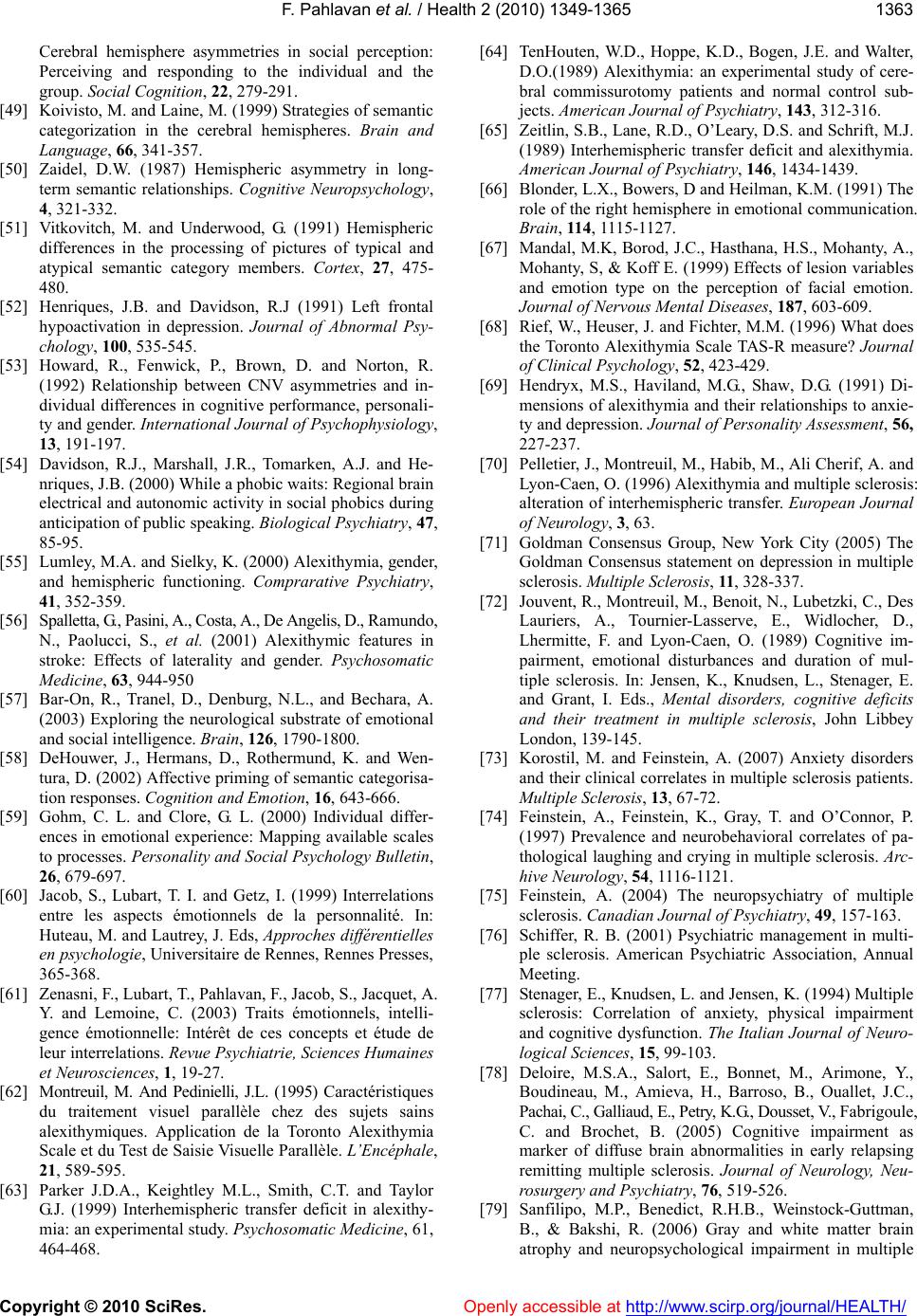 F. Pahlavan et al. / Health 2 (2010) 1349-1365 Copyright © 2010 SciRes. Openly accessible at http://www.scirp.org/journal/HEALTH/ 1363 Cerebral hemisphere asymmetries in social perception: Perceiving and responding to the individual and the group. Social Cognition, 22, 279-291. [49] Koivisto, M. and Laine, M. (1999) Strategies of semantic categorization in the cerebral hemispheres. Brain and Language, 66, 341-357. [50] Zaidel, D.W. (1987) Hemispheric asymmetry in long- term semantic relationships. Cognitive Neuropsychology, 4, 321-332. [51] Vitkovitch, M. and Underwood, G. (1991) Hemispheric differences in the processing of pictures of typical and atypical semantic category members. Cortex, 27, 475- 480. [52] Henriques, J.B. and Davidson, R.J (1991) Left frontal hypoactivation in depression. Journal of Abnormal Psy- chology, 100, 535-545. [53] Howard, R., Fenwick, P., Brown, D. and Norton, R. (1992) Relationship between CNV asymmetries and in- dividual differences in cognitive performance, personali- ty and gender. International Journal of Psychophysiology, 13, 191-197. [54] Davidson, R.J., Marshall, J.R., Tomarken, A.J. and He- nriques, J.B. (2000) While a phobic waits: Regional brain electrical and autonomic activity in social phobics during anticipation of public speaking. Biological Psychiatry, 47, 85-95. [55] Lumley, M.A. and Sielky, K. (2000) Alexithymia, gender, and hemispheric functioning. Comprarative Psychiatry, 41, 352-359. [56] Sp al le tt a, G., Pas i ni , A . , Co s ta, A ., De An ge l is , D. , Ramundo, N., Paolucci, S., et al. (2001) Alexithymic features in stroke: Effects of laterality and gender. Psychosomatic Medicine, 63, 944-950 [57] Bar-On, R., Tranel, D., Denburg, N.L., and Bechara, A. (2003) Exploring the neurological substrate of emotional and social intelligence. Brain, 126, 1790-1800. [58] DeHouwer, J., Hermans, D., Rothermund, K. and Wen- tura, D. (2002) Affective priming of semantic categorisa- tion responses. Cognition and Emotion, 16, 643-666. [59] Gohm, C. L. and Clore, G. L. (2000) Individual differ- ences in emotional experience: Mapping available scales to processes. Personality and Social Psychology Bulletin, 26, 679-697. [60] Jacob, S., Lubart, T. I. and Getz, I. (1999) Interrelations entre les aspects émotionnels de la personnalité. In: Huteau, M. and Lautrey, J. Eds, Approches différentielles en psychologie, Universitaire de Rennes, Rennes Pre sses, 365-368. [61] Zenasni, F., Lubart , T., Pahlavan, F., Jac ob, S., Jac quet, A. Y. and Lemoine, C. (2003) Traits émotionnels, intelli- gence émotionnelle: Intérêt de ces concepts et étude de leur interre lati ons. Revue Psychiatrie, Sciences Humaines et Neurosciences, 1, 19-27. [62] Montreuil, M. And Pedinielli, J.L. (1995) Caractéristiques du traitement visuel parallèle chez des sujets sains alexithymiques. Application de la Toronto Alexithymia Scale et du Test de Saisie Visuelle Parallèle. L’Encéphale, 21, 589-595. [63] Parker J.D.A., Keightley M.L., Smith, C.T. and Taylor G.J. (1999) Interhemispheric transfer deficit in alexithy- mia: an experimental study. Psychosomatic Medicine, 61, 464-468. [64] TenHouten, W.D., Hoppe, K.D., Bogen, J.E. and Walter, D.O.(1989) Alexithymia: an experimental study of cere- bral commissurotomy patients and normal control sub- jects. American Journal of Psychiatry, 143, 312-316. [65] Zeitlin, S.B., Lane, R.D., O’Leary, D.S. and Schrift, M.J. (1989) Interhemispheric transfer deficit and alexithymia. American Journal of Psychiatry, 146, 1434-1439. [66] Blonder, L.X., Bowers, D and Heilman, K.M. (1991) The role of the right hemisphere in emotional communication. Brain, 114, 1115-1127. [67] Mandal, M.K, Borod, J.C., Hasthana, H.S., Mohanty, A., Mohanty, S, & Koff E. (1999) Effects of lesion variables and emotion type on the perception of facial emotion. Journal of Nervous Mental Diseases, 187, 603-609. [68] Rief, W., Heuser, J. and Fichter, M.M. (1996) What does the Toronto Alexithymia Scale TAS-R measure? Journal of Clinical Psychology, 52, 423-429. [69] Hendryx, M.S., Haviland, M.G., Shaw, D.G. (1991) Di- mensions of alexithymia and their relationships to anxie- ty and depression. Journal of Personality Assessment, 56, 227-237. [70] Pelletier, J., Montreuil, M., Habib, M., Ali Cherif, A. and Ly on-Caen, O. (1996) Alexithymia and multiple sclerosis: alteration of interhemispheric transfer. European Journal of Neurology, 3, 63. [71] Goldman Consensus Group, New York City (2005) The Goldman Consensus statement on depression in multiple sclerosis. Multiple Sclerosis, 11, 328-337. [72] Jouvent, R., Montreuil, M., Benoit, N., Lubetzki, C., Des Lauriers, A., Tournier-Lasserve, E., Widlocher, D., Lhermitte, F. and Lyon-Caen, O. (1989) Cognitive im- pairment, emotional disturbances and duration of mul- tiple sclerosis. In: Jensen, K., Knudsen, L., Stenager, E. and Grant, I. Eds., Mental disorders, cognitive deficits and their treatment in multiple sclerosis, John Libbey London, 139-145. [73] Korostil, M. and Feinstein, A. (2007) Anxiety disorders and their clinical correlates in multiple sclerosis patients. Multiple Sclerosis, 13, 67-72. [74] Feinstein, A., Feinstein, K., Gray, T. and O’Connor, P. (1997) Prevalence and neurobehavioral correlates of pa- thological laughing and crying in multiple sclerosis. Arc- hive Neurology, 54, 1116-1121. [75] Feinstein, A. (2004) The neuropsychiatry of multiple sclerosis. Canadian Journal of Psychiatry, 49, 157-163. [76] Schiffer, R. B. (2001) Psychiatric management in multi- ple sclerosis. American Psychiatric Association, Annual Meeting. [77] Stenager, E., Knudsen, L. and Jensen, K. (1994) Multiple sclerosis: Correlation of anxiety, physical impairment and cognitive dysfunction. The Italian Journal of Neuro- logical Sciences, 15, 99-103. [78] Deloire, M.S.A., Salort, E., Bonnet, M., Arimone, Y., Boudineau, M., Amieva, H., Barroso, B., Ouallet, J.C., Pachai, C. , Galliau d, E., P etry, K.G., Dousset, V., Fabrigoule, C. and Brochet, B. (2005) Cognitive impairment as marker of diffuse brain abnormalities in early relapsing remitting multiple sclerosis. Journal of Neurology, Neu- rosurgery and Psychiatry, 76, 519-526. [79] Sanfilipo, M.P., Benedict, R.H.B., Weinstock-Guttman, B., & Bakshi, R. (2006) Gray and white matter brain atrophy and neuropsychological impairment in multiple 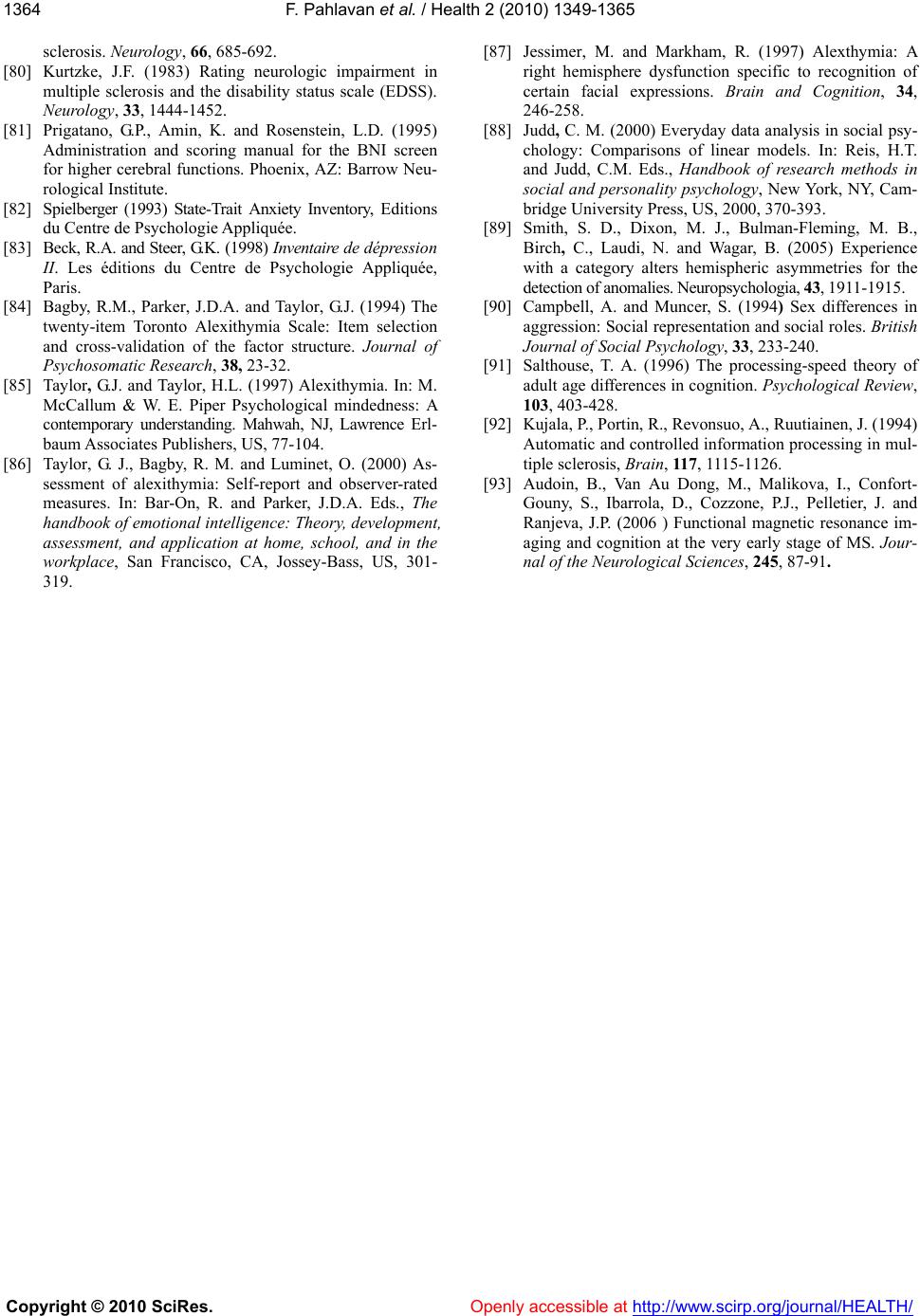 F. Pahlavan et al. / Health 2 (2010) 1349-1365 Copyright © 2010 SciRes. Openly accessible at http://www.scirp.org/journal/HEALTH/ 1364 sclerosis. Neurology, 66, 685-692. [80] Kurtzke, J.F. (1983) Rating neurologic impairment in multiple sclerosis and the disability status scale (EDSS). Neurology, 33, 1444-1452. [81] Prigatano, G.P., Amin, K. and Rosenstein, L.D. (1995) Administration and scoring manual for the BNI screen for higher cerebral functions. Phoenix, AZ: Barrow Neu- rological Institute. [82] Spielberger (1993) State-Trait Anxiety Inventory, Editions du Centre de Psychologie Appliquée. [83] Beck, R.A. and Steer, G. K. (1998) Inventaire de dépressio n II. Les éditions du Centre de Psychologie Appliquée, Paris. [84] Bagby, R.M., Parker, J.D.A. and Taylor, G.J. (1994) The twenty-item Toronto Alexithymia Scale: Item selection and cross-validation of the factor structure. Journal of Psychosomatic Research, 38, 2 3-32. [85] Tayl or, G.J. and Taylor, H.L. (1997) Alexithymia. In: M. McCallum & W. E. Piper Psychological mindedness: A contemporary understanding. Mahwah, NJ, Lawrence Erl- baum Associates Publishers, US, 77-104. [86] Taylor, G. J., Bagby, R. M. and Luminet, O. (2000) As- sessment of alexithymia: Self-report and observer-rated measures. In: Bar-On, R. and Parker, J.D.A. Eds., The handbook of emotional intelligence: Theory, development, assessment, and application at home, school, and in the workplace, San Francisco, CA, Jossey-Bass, US, 301- 319. [87] Jessimer, M. and Markham, R. (1997) Alexthymia: A right hemisphere dysfunction specific to recognition of certain facial expressions. Brain and Cognition, 34, 246-258. [88] Judd, C. M. (2000) Everyday data analysis in social psy- chology: Comparisons of linear models. In: Reis, H.T. and Judd, C.M. Eds., Handbook of research methods in social and personality psychology, New York, NY, Cam- bridge University Press, US, 2000, 370-393. [89] Smith, S. D., Dixon, M. J., Bulman-Fleming, M. B., Birch, C., Laudi, N. and Wagar, B. (2005) Experience with a category alters hemispheric asymmetries for the detection of anomalies. Neurops ycholo gia, 43, 1911-1915. [90] Campbell, A. and Muncer, S. (1994) Sex differences in aggression: Social representation and social roles. British Journal of Social Psychology, 33, 233-240. [91] Salthouse, T. A. (1996) The processing-speed theory of adult age differences in cognition. Psychological Review, 103, 403-428. [92] Kujala, P., Portin, R., Revonsuo, A., Ruutiai n en, J. (1994) Automatic and controlled information processing in mul- tiple sclerosis, Brain, 117, 1115-1126. [93] Audoin, B., Van Au Dong, M., Malikova, I., Confort- Gouny, S., Ibarrola, D., Cozzone, P.J., Pelletier, J. and Ranjeva, J.P. (2006 ) Functional magnetic resonance im- aging and cognition at the very early stage of MS. Jour- nal of the Neurological Sciences, 245, 87-91. 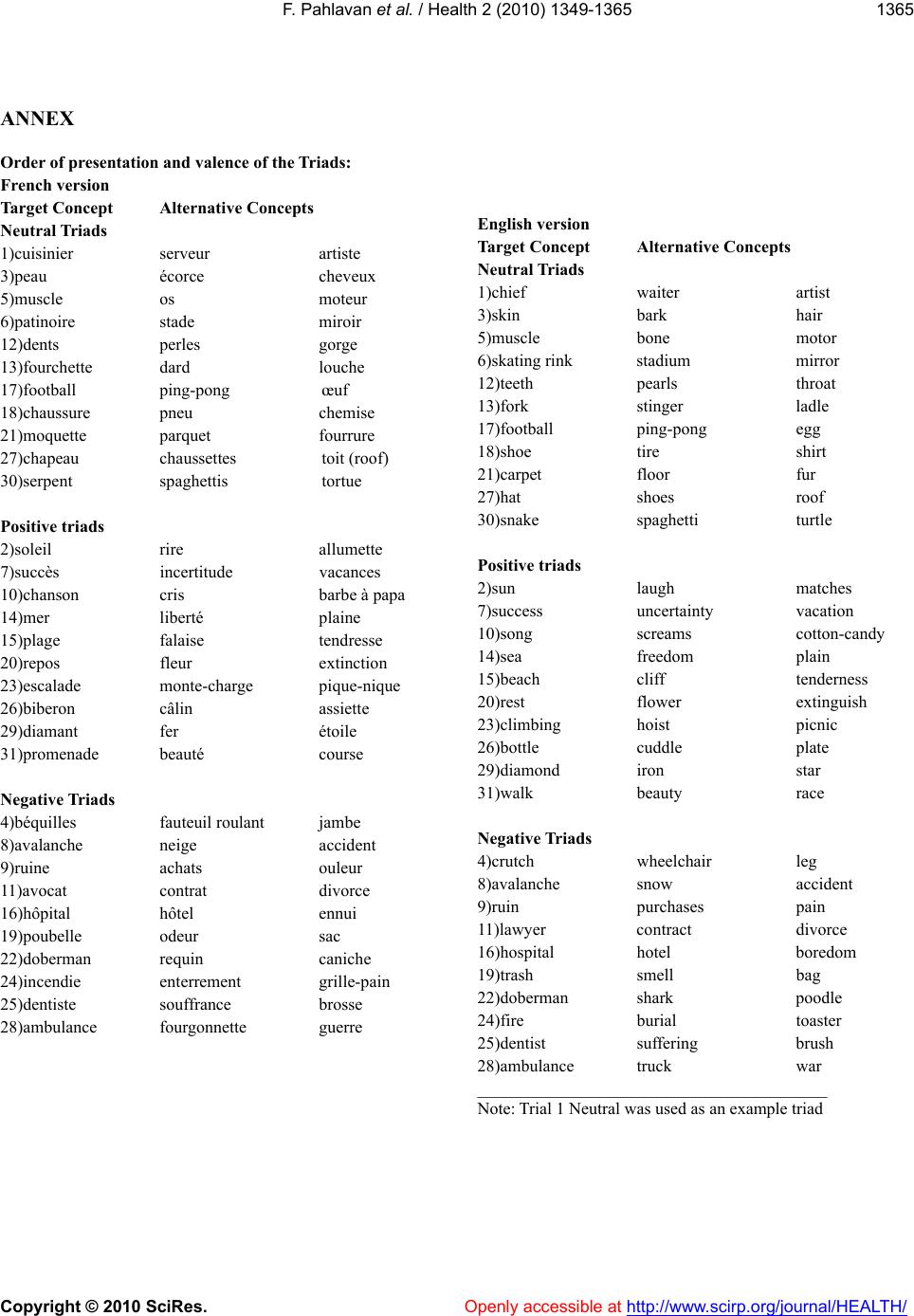 F. Pahlavan et al. / Health 2 (2010) 1349-1365 Copyright © 2010 SciRes. Openly accessible at http://www.scirp.org/journal/HEALTH/ 1365 ANNEX Order of presentation and valence of the Triads: French version Target Concept Alternative Concepts Neutral Triads 1)cuisinier serveur artiste 3)peau écorce cheveux 5)muscle os moteur 6)patinoire stade miroir 12)dents perles gorge 13)fourchette dard louche 17)football ping-pong œuf 18)chaussure pneu chemise 21)moquette parquet fourrure 27)chapeau chaussettes toit (roof) 30)serpent spaghettis tortue Positive triads 2)soleil rire allumette 7)succès incertitude vacances 10)chanson cris barbe à papa 14)mer liberté plaine 15)plage falaise tendresse 20)repos fleur extinction 23)escalade monte-charge pique-nique 26)biberon câlin assiette 29)diamant fer étoile 31)promenade beauté course Negative Triads 4)béquilles fauteuil roulant jambe 8)avalanche neige accident 9)ruine achats ouleur 11)avocat contrat divorce 16)hôpital hôtel ennui 19)poubelle odeur sac 22)doberman requin caniche 24)incendie enterrement grille-pain 25)dentiste souffrance brosse 28)ambulance fourgonnette guerre English version Target Concept Alternative Concepts Neutral Triads 1)chief waiter artist 3)skin bark hair 5)muscle bone motor 6)skating rink stadium mirror 12)teeth pearls throat 13)fork stinger ladle 17)football ping-pong egg 18)shoe tire shirt 21)carpet floor fur 27)hat shoes roof 30)snake spaghetti turtle Positive triads 2)sun laugh matches 7)success uncertainty vacation 10)song screams cotton-candy 14)sea freedom plain 15)beach cliff tenderness 20)rest flower extinguish 23)climbing hoist picnic 26)bottle cuddle plate 29)diamond iron star 31)walk beauty race Negative Triads 4)crutch wheelchair leg 8)avalanche snow accident 9)ruin purchases pain 11)lawyer contract divorce 16)hospital hotel boredom 19)trash smell bag 22)doberman shark poodle 24)fire burial toaster 25)dentist suffering brush 28)ambulance truck war _________________________________________ Note: Trial 1 Neutral was used as an example triad |

